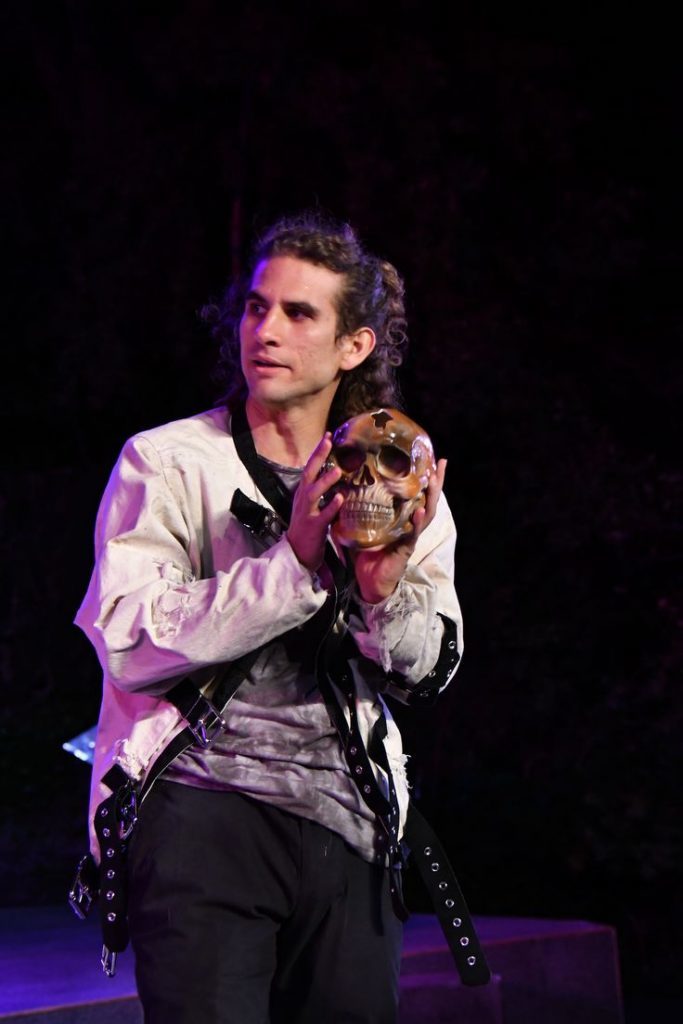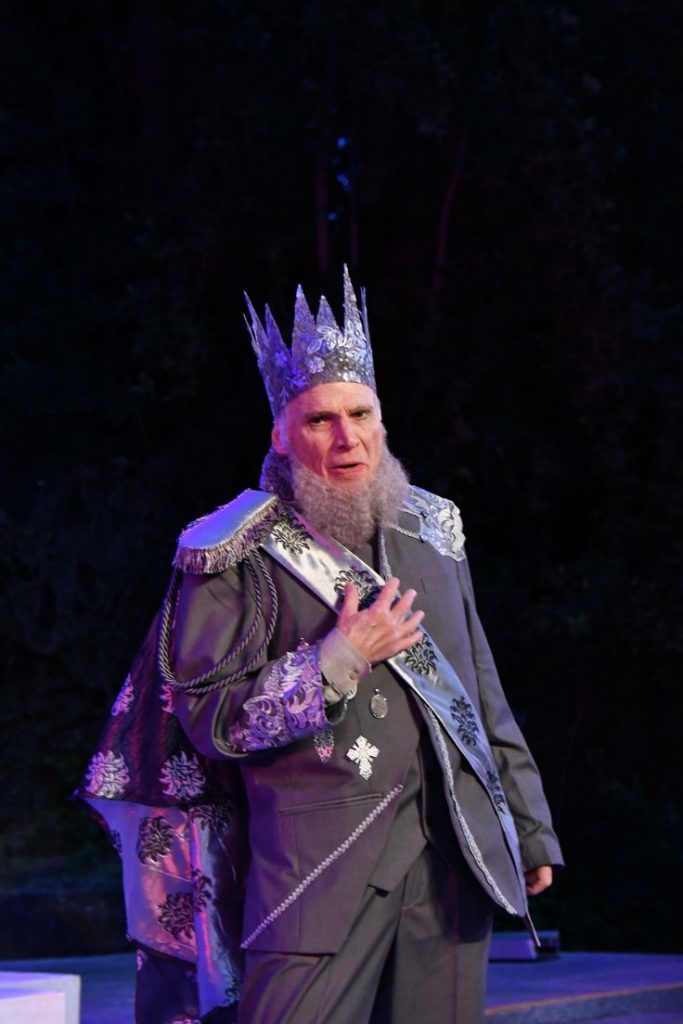Et in ARCADIA Ego: a review of Stoppard’s ARCADIA at Berkeley’s Shotgun Players
January 2, 2019 § 1 Comment
Start Your New Year Right!
I saw a lot of great theatre in 2018 from all over the world, and will be writing a bit more about it here soon. However, if you are looking for a bit of good news to launch the new year, look no further than the announcement that one of my top ten picks is still available! Patrick Dooley’s sublime production of Tom Stoppard’s Arcadia has extended through Jan 27 at Shotgun Players in Berkeley. For those who love the theatre of words and ideas, Stoppard’s play is always a treat, but Dooley’s production exceeds expectations in every way.
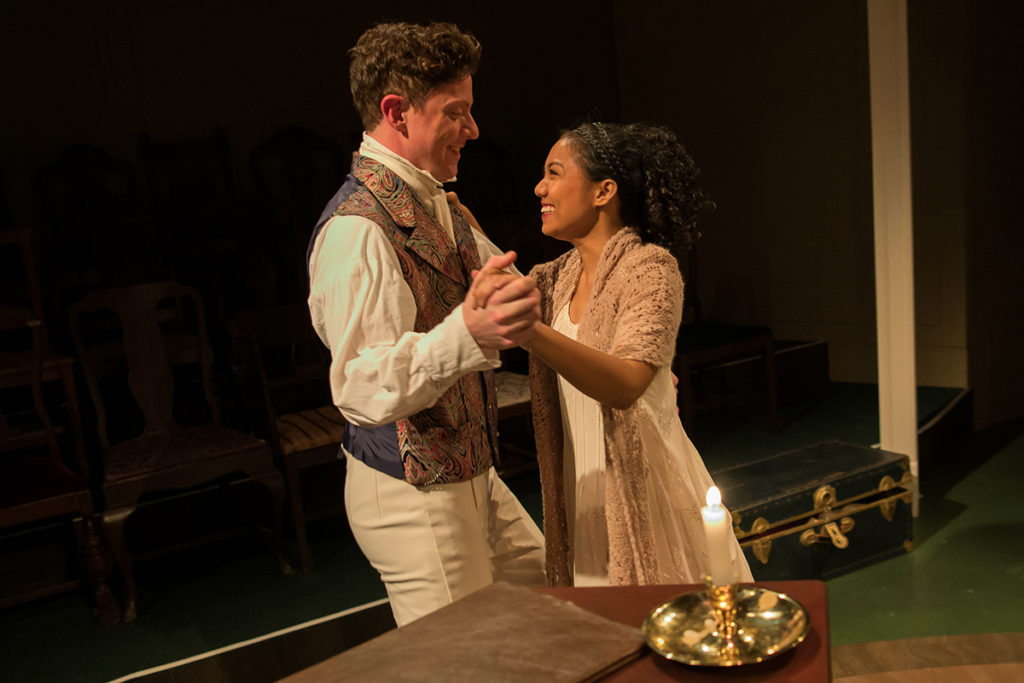
Max Forman-Mullin as Septimus Hodge; Amanda Ramos as Thomasina Coverly. All photos by Ben Krantz Studios.
Why is a Shakespearean writing about Stoppard?
An aside: My usual beat is early modern drama, especially Shakespeare, and although I like a lot of other plays and periods, I rarely write about modern drama. The reason for this is simply that the dividing line between pre-modern and modern drama is usually drawn at the advent of realism where plays suddenly start being about characters who are psychologically complex but generally inarticulate about their feelings and may not understand their own motivations.
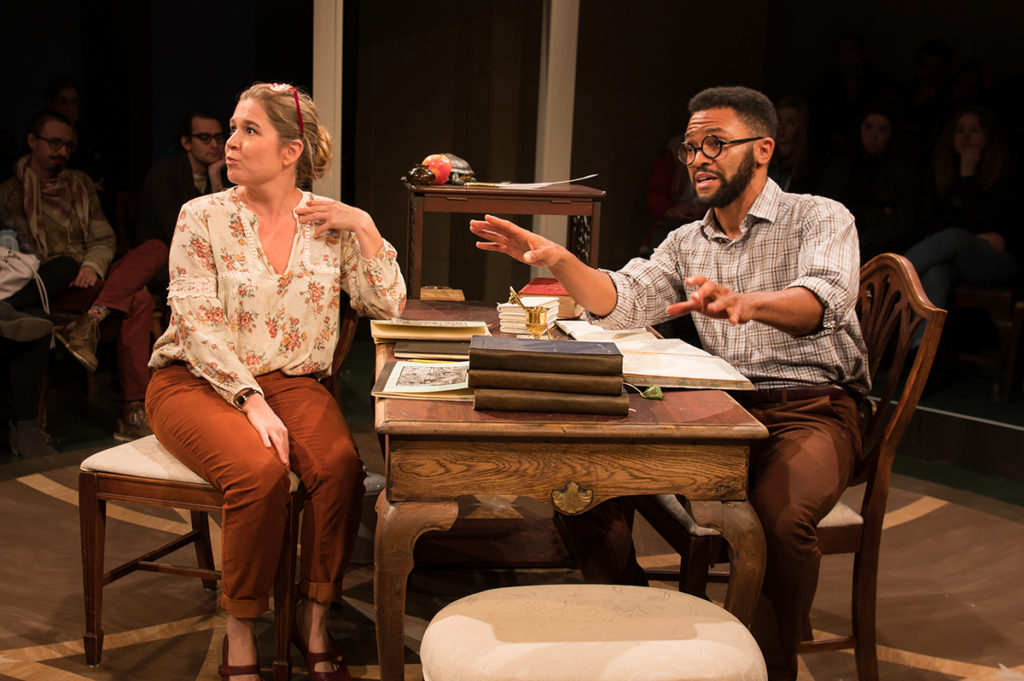
Jessma Evans as Hannah Jarvis, Gabriel Christian as Valentine Coverly; two characters in the modern scenes of the play who struggle to understand and express themselves.
My critical expertise falls on the other side of that line, with characters who are brilliantly (if unrealistically) expressive and articulate–to the point that they can sometimes put their thoughts into verse with healthy doses of rhetorical flourishes thrown in. In short, I write about performance of heightened language.
Usually the line falls more or less historically at the advent of the twentieth century, but in 2018, I saw two productions (both in Berkeley) of modern plays with linguistic brilliance that rivaled that of any classic. In the summer, Tony Kushner’s Angels in America at Berkeley Rep (with the amazing Stephen Spinella, the original Prior Walter, in role of Roy Cohn) was a–no pun intended–revelation.
A Small Theatre with Huge Impact
Surprisingly, given the very different level of resources available and invested, Shotgun Players’ late winter production of Arcadia was completely on par with the Rep’s Kushner. Shotgun’s company of exceptional actors, especially Max Forman-Mullin as Septimus Hodge and Amanda Ramos as Thomasina Coverly, invested in Stoppard’s non-stop wordplay (see what I did, or at least tried, there?) with wit, agility and stunning emotional honesty.
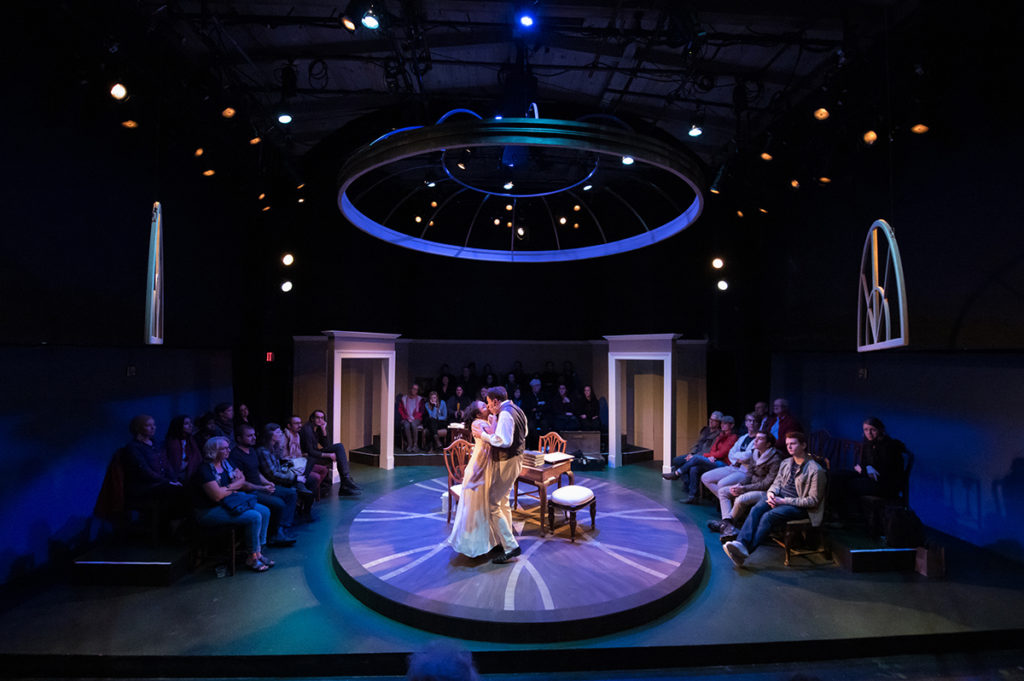
Amanda Ramos as Thomasina Coverly and Max Forman-Mullin as Septimus Hodge on Deanna L Zibello’s set with audience seated directly on the stage surrounding the players.
Patrick Dooley’s brilliant direction found every nuance in this incredibly complex plot and made it look easy, which I know from having directed this play myself, is not. In an extraordinary director’s note, Dooley emphasized the socio-political implications of the play beyond its dazzling theme and variations on love and lust, which brought even greater contemporary resonance to a play already considered a modern masterpiece.
Shotgun is a special place, and this production capitalizes on all their strengths. Their space is intimate, and made more so for this production. Rows of audience are set up on stage to create an arena staging, putting even more audience members right next to the action. The cast is as good as they have ever assembled, under their founding artistic director, who assembles very good casts. Most of all, however, is the experience of seeing this play with Shotgun’s loyal, and let’s face it, exceptional audience. The level of familiarity with this play and knowledge of the huge range of subject matters it deals with, from the history of English landscape gardening, to the poetry and personal exploits of Lord Byron, and on to modern fractal geometry, was astonishing.
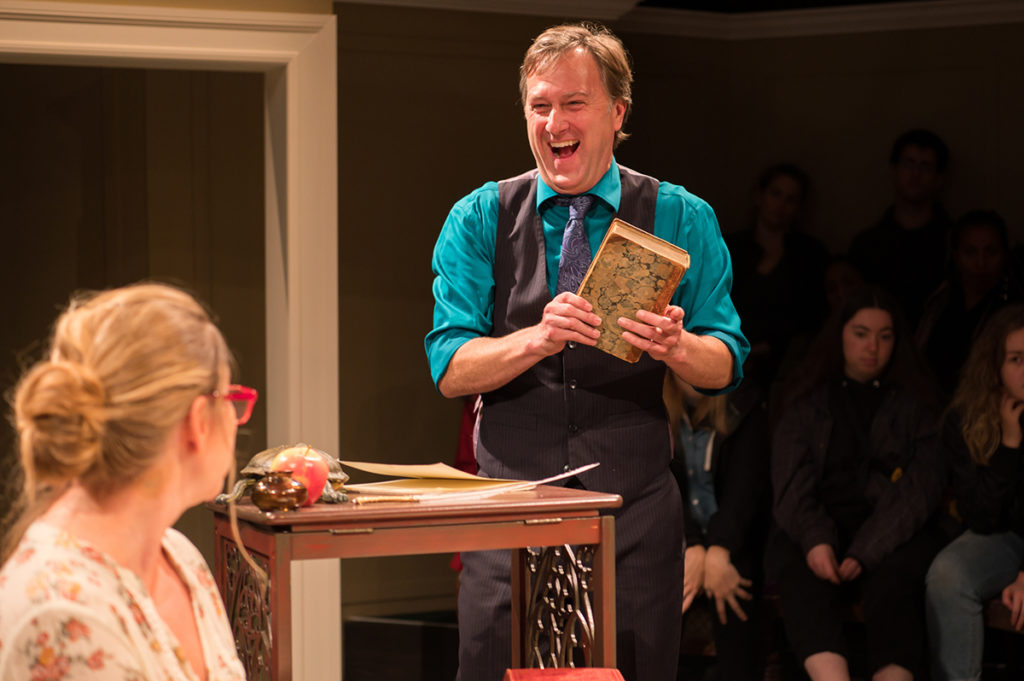
Aaron Murphy as Bernard Nightingale, a contemporary “expert” on Lord Byron.
(At intermission, an elderly couple seated next to me noticed I was making a few notes and volunteered to explain the convoluted plot to me. I accepted the offer without revealing that I knew this play very well already, and then got my comeuppance when they demonstrated, without the slightest condescension, that they actually knew it even better. It was a treat to hear their detailed and excited explication.)
Not just a Company, but a Community
A theatre is not just the artists and staff, it is also the community that they create. It is a different experience to see a play with an audience this receptive and perceptive–one to be relished. The play was sensitively interpreted by set designer Deanna L. Zibello’s minimalist arena aided greatly by the work of prop designer Devon Labelle, costume designer Brooke Jennings’ nicely coordinated period and modern costumes, lighting designer Sarina Renteria’s clever rendering of time, and Cliff Caruther’s sound design. I suspect that an unsung hero of the production might be dramaturg Dave Garrett.

Shotgun’s charming company photo, showing the complete cast and crew–emphasizing the collaborative nature of this company.
Get your year started right–go see this play. I assure you it will make you feel better about the times we live in, the state of the theatre, and the bright futures of some exceptional artists.
Production Information:
Arcadia is playing through Jan 27
Shotgun Players
1901 Ashby Avenue Berkeley, CA 94703
Tel: 510.841.6500
Website: shotgunplayers.org
Twelve Nights, Six Actors: A Review of TWELFTH NIGHT at the Arabian Shakespeare Festival
November 8, 2018 § 3 Comments
Shakespeare’s plays are undoubtedly great literature, but it is easy to forget that they are also amazing acting machines. The Arabian Shakespeare Festival’s current Twelfth Night is so full of virtuoso performances, including some very unexpected casting and doublings, that I am reminded again that when you bet big on the actors, small is beautiful.
This is ASF’s first foray into Shakespeare’s comedies, after a series of performances of tragedies I admired–especially a conceptually brilliant Othello in 2014. I was not sure how their house style and mission might adjust to this switch. Any doubts I might have had were almost instantly swept away by the sheer joy of playing exhibited by the charming, versatile and skillful cast of six.
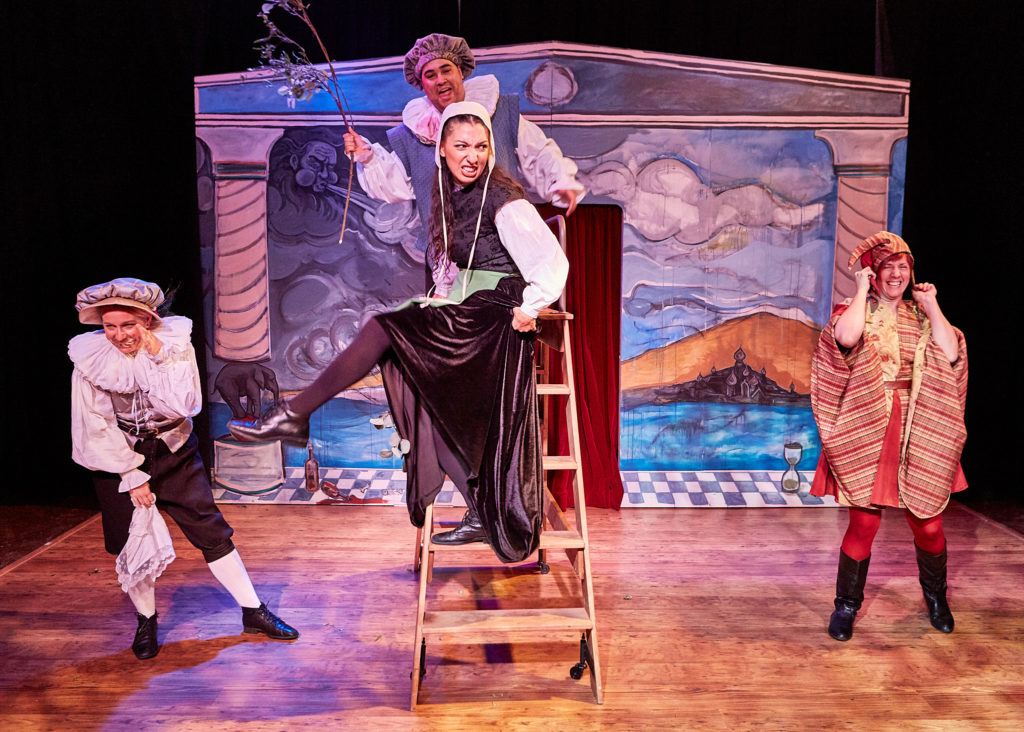
(l to r) Sir Andrew (Jennifer Le Blanc), Sir Toby (John R. Lewis), Maria (Livia Gomes Demarchi), and Feste (Rebecca Pingree) celebrate as their schemes come to fruition, in Arabian Shakespeare Festival’s production of Twelfth Night.
Layers of Delight
Twelfth Night is one of the middle comedies, with twenty roles in the cast list. I’ve seen wonderful productions of the play that were produced with a one actor/one role casting scheme. In these, the bittersweet story of a pair of separated twins (each believing the other lost at sea) who slowly work their way back to a reunion, the overthrow of a puritanical steward standing in the way of pleasure, and the surprising manner in which the courtship of a grieving countess by an admiring Duke ends in happily in marriage–just not to each other, was always satisfying. That is one layer of delight and it can be enough, in and of itself.
ASF’s production, insightfully designed and directed by Audrey Rumsby, sounds all those notes, but it has many more layers in play that make it much more than the sum of those parts.
Rumsby’s set design, echoing the central prop in the play, a toy theatre/music box, turns the Royce Gallery’s tiny playing space into a virtue. We know from her concept that we are seeing an imaginative romp. It invites us to think of the play as literal “play,” a game in progress. Elizabeth Smith’s whimsical costume designs capture the essence of each character, which is crucially important since actors quickly switch from one role to another with additions or subtractions of only a piece or two.
Thou Art Translated!
The cast uniformly delivers on the promise of this premise! John R. Lewis is a dignified and outstanding, if unconventional, Duke Orsino, but with the addition of a big, winestained ruff he transforms into Orsino’s antipode, the perfectly-named drunken reprobate, Sir Toby Belch. Watching him switch back-and-forth is enchanting above and beyond anything that he does in either role–a layer of pleasure that you don’t get in a conventional staging.
Rebecca Pingree raises the bar higher in her main role as the jester, Feste, as she demonstrates some serious musical chops in addition to her acting skills. (The whole production, in fact, is filled with excellent live music performed by the cast, under the musical direction of Lindsey Schmeltzer.) Very early on she doubles the usually forgettable role of the unnamed “Captain” in a surprisingly convincing masculine portrait, but reserves her comic firepower for a thoroughly confused (and confusing) priest in the play’s finale. She is terrific in all three parts.
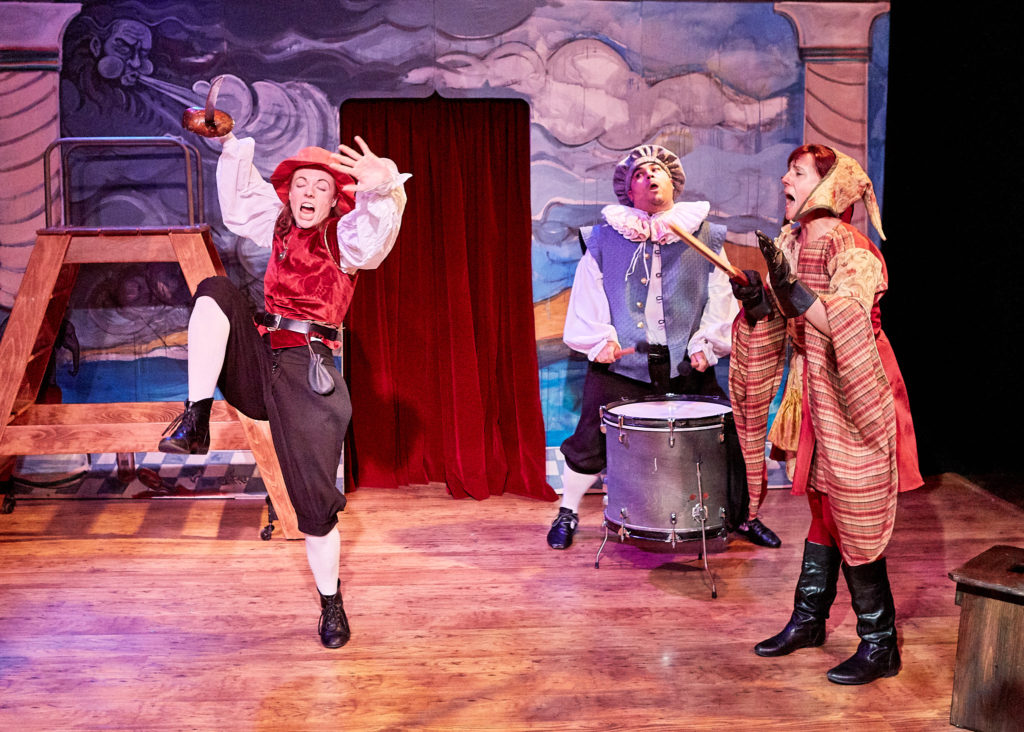
(l to r) Viola (Kate Rose Reynolds) prepares to fight a duel with Sir Toby (John R. Lewis), as Feste (Rebecca Pingree) look on.
Amelia Adams grounds her portraits of the male twin, Sebastian, and the insufferable puritan Malvolio in the physical techniques of Commedia dell’Arte. Neither role is realistically convincing, nor meant to be. (ASF could have cast a male actor, after all, if that was the goal.) Instead, both parts are suffused with deep observational insights about how we construct “leading men” and “the authority of male privilege” that can only be conveyed to an audience when they are obviously put on, instead of inherent in the actor.
Livia Gomes Demarchi plays two female roles at opposite ends of the “leading vs. character women” spectrum. As the Countess Olivia she is proud in declining the proffers of love from Duke Orsino but reduced to a quivering jelly in the presence of “Cesario,” whom she adores without realizing she is pursuing a disguised woman. As Maria, the pragmatic, scheming lady-in-waiting she is almost unrecognizable as the same actress although all that has really changed is the addition of a bonnet.
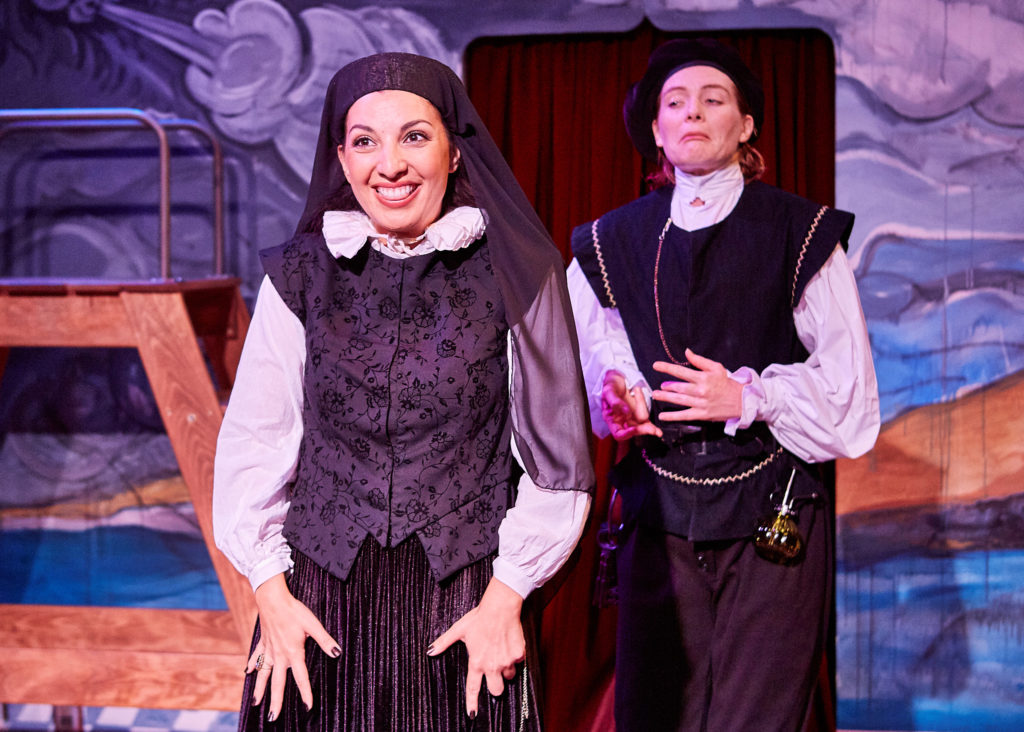
(l to r) Olivia (Livia Gomes Demarchi) reflects on her first meeting with Viola to her puritanical steward, Malvolio (Amelia P. Adams)
Kate Rose Reynolds plays the afore-mentioned twin-in-disguise, Viola/Cesario, (in both her female and male forms) with panache. This is the only “doubling” built into the play, and if it is unsurprising, it is no less entertaining because we see it in the context of a whole shape-shifting cast. I’ve seen an awful lot of “Cesarios” whose entire characterization appeared to be wearing a hat, but Reynolds seriously explores the mental transformation of her character when she assumes the male persona for protection. Hers is the most insightful Viola of my experience.
The actor in the announced cast with which I was most familiar previously was Jennifer Le Blanc, whose Desdemona for this company thrilled me. I was so disappointed to see that she would be playing two minor parts, neither of which seemed to me to make particularly good use of her talents: Sir Andrew Aguecheek, and the dedicated (probably lovesick) protector of Sebastian, the sea captain Antonio. I saved discussion of her performance for last, because I could not have been more wrong. She was astonishing–hysterically funny and heartbreakingly serious by turns–all night long. I found myself desperately racing ahead through the play’s scenes in my mind thinking about how soon I would see her again any time she left the stage. The virtuosity of the performances, of the transformations, and of the ensemble work was exemplary. Above all, her joy in playing the roles was palpable.
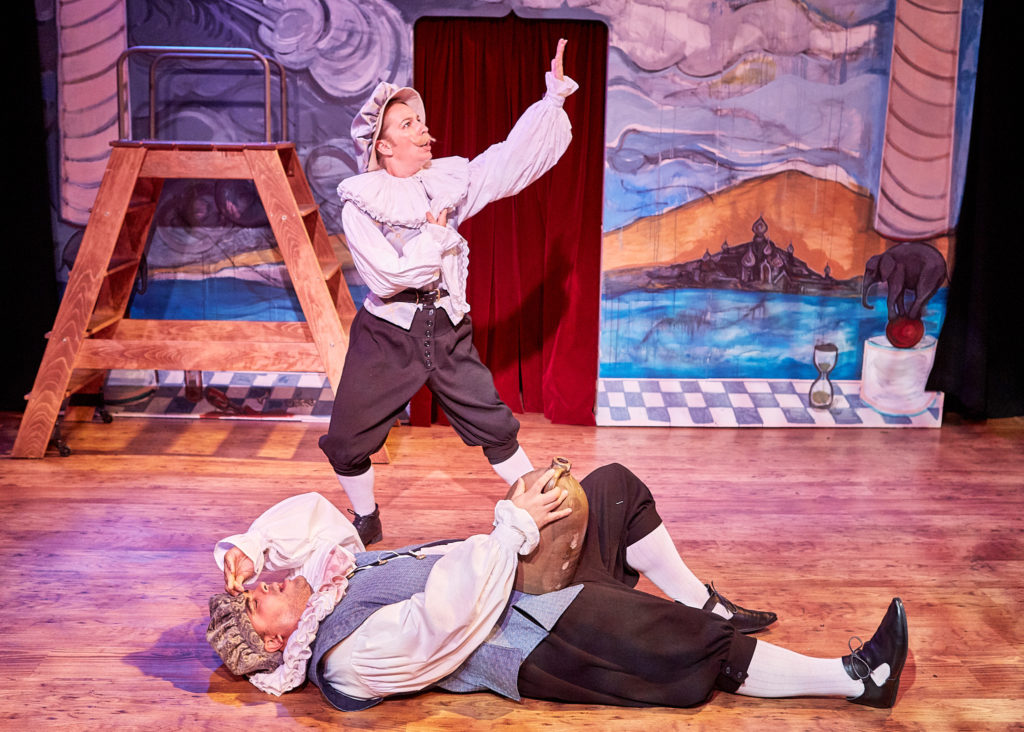
(l to r) Sir Toby (John R. Lewis) and Sir Andrew (Jennifer Le Blanc) drink and celebrate late into the night. All photos by Gregg Le Blanc of Cumulus Light Photography
The Means Are Limited but the Pay-off Is HUGE
ASF’s production is intimate. The space is small. The cast is reduced to just six players. The set and costumes are simple. The means are limited but the pay-off is huge. The play is actually MORE enjoyable because of the imaginative and versatile way that it is produced. I admire this company and have championed their work in the past, but now I have to say that as it matures it improves.
TL;DR
If you love Shakespeare, go see this production. If you love the theatre, go see this production. If you want to deeply understand why Shakespeare is the quintessential theatre artist, do not miss this production! There aren’t many seats. Get one while you can.
More Information
Twelfth Night – Nov.1–18, 2018, By William Shakespeare / Directed by Audrey Rumsby
Royce Gallery – 2901 Mariposa St., San Francisco, CA 94110
Online: www.ArabianShakes.org
By phone: 408-499-0017
This review is of the Sunday, Nov. 4 performance.
Brett Gamboa’s Brilliant Take on Doubling (and a lot of related stuff!) in Shakespeare
July 17, 2018 § Leave a Comment
This blog is concerned with the art of Shakespeare in performance, but the truth is that I review surprisingly few scholarly books here because it is frustratingly rare for one to perceptively address this issue. Now, however, there is a genuinely outstanding new book out that seems on its surface to be about a very narrow issue (doubling roles by actors in Shakespeare’s plays) and turns out to be about an entire range of performance issues that sneak in through that tiny crack. I recommend it without hesitation.
The book is Brett Gamboa’s Shakespeare’s Double Plays: Dramatic Economy on the Early Modern Stage. Professor Gamboa (of Dartmouth University) is the best kind of scholar-practitioner, and his book is essential reading for anyone seriously thinking about the plays in performance.
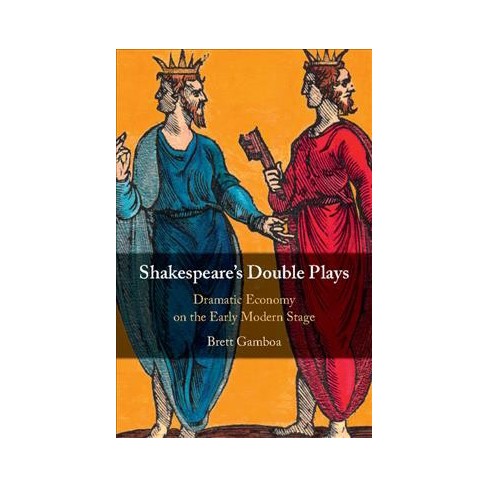
The cover of Gamboa’s new book
Gamboa’s book is a radical rethinking of the nature and significance of doubling (that is, an actor playing two or more characters in a production) in Shakespeare’s plays. His conclusions are startlingly original, and vastly different from the generally received ideas about how Shakespeare’s plays were performed in his own time and how they ought to be performed in ours.
Two Boards, a Dozen Actors and a Passion
Speaking with a practitioner’s voice, Gamboa flatly states that ALL of the plays in the canon can be performed by just 12 speaking actors, and are “more engaging, more pleasurable, sometimes even more credible” when they are. (Contrast this with, say, the New Oxford Shakespeare’s assertion that A Midsummer Night’s Dream, for example, requires a minimum of 12 adult males and an additional 10 apprentices/children because essentially no roles can be doubled in it, and you get a sense of how different Gamboa’s ideas are from even very recent scholarship on the subject.) He quickly disavows any ability to PROVE his thesis based on extant casting records or other historical evidence, but he is also quick to point out the myriad ways that the evidence does not support the generally accepted conclusions, either.
Gamboa, instead, argues very persuasively on aesthetic, dramaturgical, and practical grounds that the centrality of doubling to Shakespeare’s practice has never been properly explored, and its extent vastly underestimated. When combined with a critical reexamination of the historical evidence, he brings new insights into probable “original practice” and raises exciting possibilities for contemporary performance practice, training and production.
Along the way, he challenges a lot of standard narratives. He finds no reason to believe that Shakespeare and his fellow sharers, that is co-owners of the company, would refuse to play multiple parts in a production, however widespread the view has become in our time that the practice was confined to hired extras in small parts. He is equally dubious about the artistic and economic possibility of boy actors taking on major roles like Rosalind, Cleopatra and Volumnia after only a couple of years of training – or that there was a steady stream of apprentices (basically an entire stable of trainees) being maintained at all times to fill in for teenagers graduating to male roles as soon as their voices broke.
A much more likely scenario, given the evidence we have and our knowledge of the practical limitations on resources is that actors played females roles well into their twenties, that they sometimes doubled both male and female roles in a single production, and that these were highly skilled performances that depended on intentionally theatrical artifice rather than verisimilitude.
Beyond “Vulgar Necessity”
At the center of Gamboa’s argument, however, is not quibbling over whether theatre historians have overreached the evidence when putting forth their opinions. Instead, he focuses squarely on the compelling aesthetic patterns that emerge when doubling is not thought of as a “vulgar necessity” as one prominent scholar labeled it, but an integral practice for making meaning. His literary and theatrical insights are, well, thrilling.

Author Brett Gamboa
As but one example, he discusses how the Nurse’s otherwise inexplicable tirade on the death of Tybalt, in Romeo and Juliet, in which she calls him her best friend despite their having NO relationship in the play until that point, becomes meaningful in numerous new ways if we consider that the same actor might have played both parts. Among other things, it highlights the actor’s virtuosity to foreground the doubling, and provides another layer of pleasure to the audience when included in the “in-joke.”
If there only one or two such ideas in the book, it might feel like a stretch, but Gamboa is revelatory about every play in the canon, often highlighting numerous doubling possibilities that extend meaning through repetition or juxtaposition across multiple characters.
This is the most thoughtfully provocative book about Shakespeare’s practice I have read in years. It has enormous implications for how we train actors and directors, how we understand the dramaturgical structures of the plays, how we teach theatre history, and most of all, how we produce and perform the plays in our own time.
More Information:
Shakespeare’s Double Plays by Brett Gamboa
May 2018
Cambridge University Press
ISBN: 9781108417433
click ISBN for the Cambridge U website.
$99 from multiple retailers. E-book: $80
An Epic PERICLES at Marin Shakespeare
July 16, 2018 § Leave a Comment
Pericles is generally held to be minor Shakespeare. It was not included in the First Folio, has no reliable text, and was (according to almost all reputable scholars, who credit co-author George Wilkins) only partially written by the Bard. You never read it in school, and you only rarely get to see it. That is a pity, because – with some competent dramaturgy – it works wonderfully well in the theatre. Exhibit A is a delightfully emotional/entertaining production at Marin Shakespeare directed by Lesley Schisgall Currier and starring Dameion Brown in the title role.
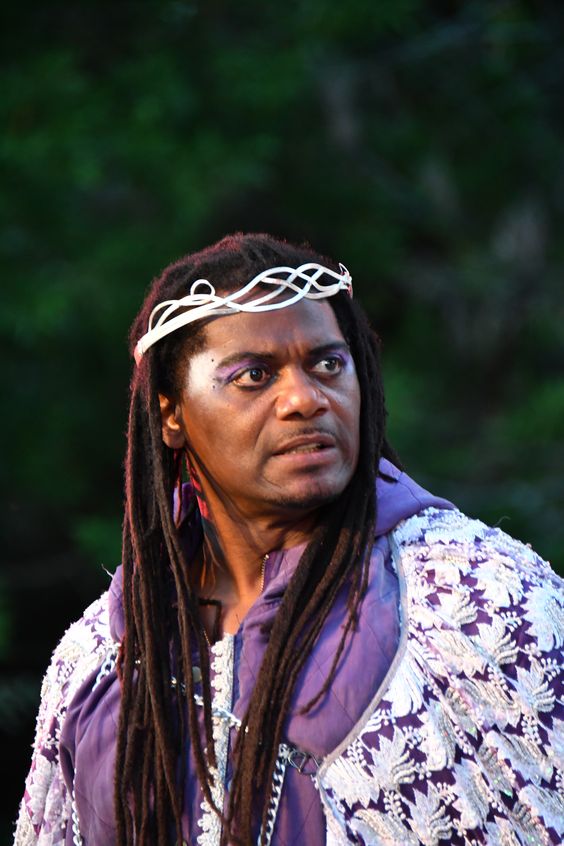
Dameion Brown playing Pericles. All photos by Jay Yamada, courtesy of Marin Shakespeare.
Darkest before the Dawn
Pericles is one of the late plays, collectively labeled the Romances, which are generically tragi-comedies. (The others are The Tempest, The Winter’s Tale and Cymbeline.) These plays veer into the darkest of tragic places including the dissolution of the protagonist’s sanity and the apparent deaths of all he holds dear before reversing course and miraculously ending happily. If you get the tone wrong, they can seem manipulative and melodramatic, but if you get it right – and Marin Shakes gets it exactly right – they are indescribably moving. Currier finds the perfect balance of humor, sentiment and mythos to unleash the play’s power.
The play is too stuffed with incident to even attempt a plot summary, but this abundance of adventure, misfortune and eventual resolution is part of what makes it so alluring in the theatre. The action barely takes time to pause as Pericles’ epic journey races from one incident to the next, over decades and continents.
Double, Double…
The production uses a speaking ensemble of 10, many doubling and tripling roles in virtuosic turns. There is a not a weak link to be found, but Kathryn Smith-McGlynn is especially radiant as Thaisa and brilliantly hysterical as her polar opposite, the Bawd.
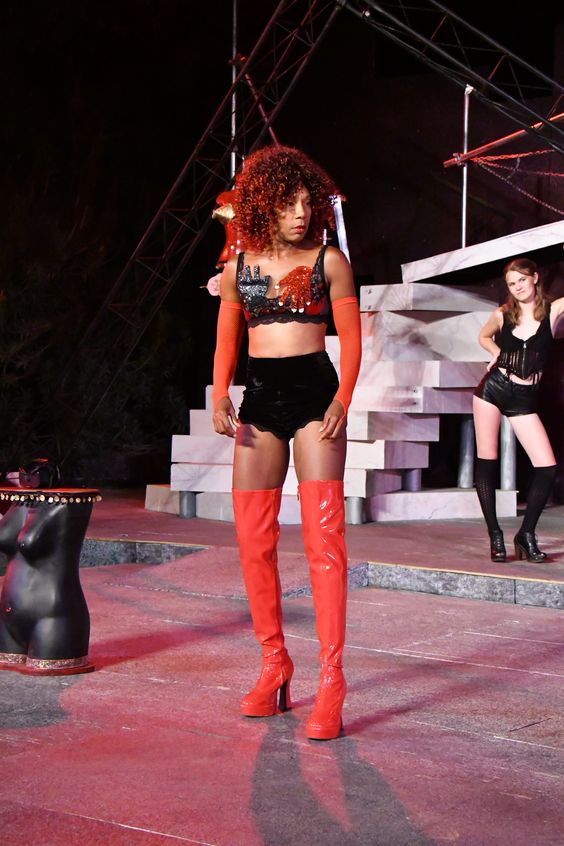
Kathryn Smith-McGlynn as the Bawd
Elena Wright perfectly sets the tone of the night as a petulant daughter to Antiochus, and is later stunningly commanding as the doctor, Cerimon.
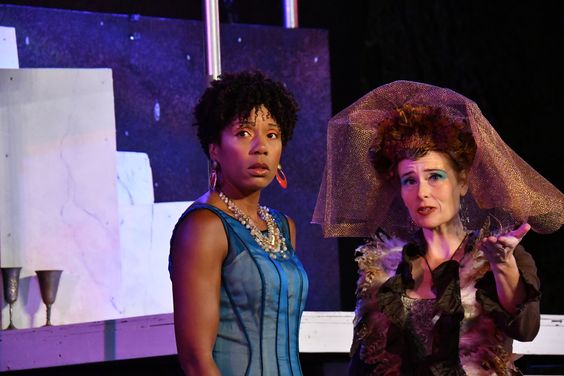
Smith-McGlynn as Thaisa and Elena Wright as Cerimon
It is hard to image any actor finding greater range in roles than the exceptional Rod Gnapp does with the heroic and noble retainer Helicanus contrasted with the relentlessly randy jack-of-all-trades in the brothel, Boult.
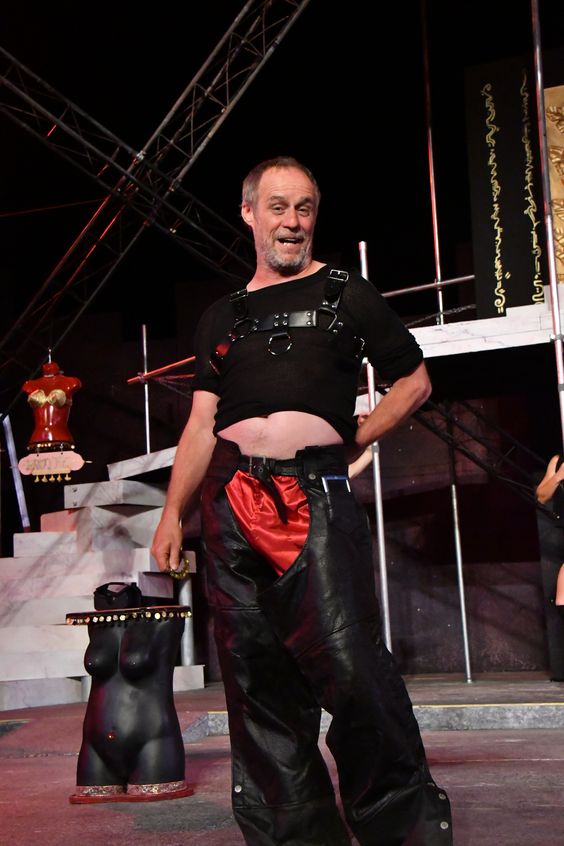
Rod Gnapp as Boult
The entire production is moved briskly along by Diane Wasnak in the role of the narrator, Gower. This is a difficult, and often thankless, role, but she handled it with such clarity and precision that I looked forward to her every appearance.
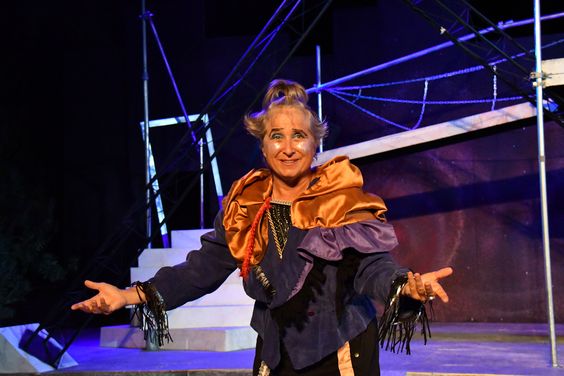
Diane Wasnak as Gower
At the heart of the production is the relationship between Pericles and the daughter he gave up in infancy and believes to have died in her teens before they could be reunited. The daughter, Marina, is beautifully played by Eliza Boivin. Brown is powerfully emotional all night long, but at his best in the extraordinary scene he shares with her near the end of the play.

Eliza Boivin as Marina with Dameion Brown as Pericles.
Brown is a phenomenon all his own. A former inmate at Salano State Prison, he was discovered and trained by director Currier in their Shakespeare-in-prisons program. Upon his release, he made his professional debut as Othello for Marin Shakespeare, winning a number of best actor awards in the Bay Area. Knowing this history, it is hard not to see the emotional depth in his performance as a man who believes he has lost everything only to find redemption and second chances after decades of misfortune. If you love Shakespeare, you’d be crazy to miss this performance, even if it had no other virtues than the realization of this beautiful scene. Of course, it does have other virtues, and lots of them!
This company is not spectacle oriented but Jackson Currier’s set design is suggestive of the cosmic scale of the epic play. Merissa Mann, the costume designer, has the unenviable task of costuming this play that requires literally hundreds of costumes. Those most central to the production are wonderfully executed but, unfortunately, in the production’s only real downside, many of the costumes for minor characters and extras seem chosen for their ability to be changed quickly and neither look good nor fit. Joel Eis’ props, by contrast are comically perfect.
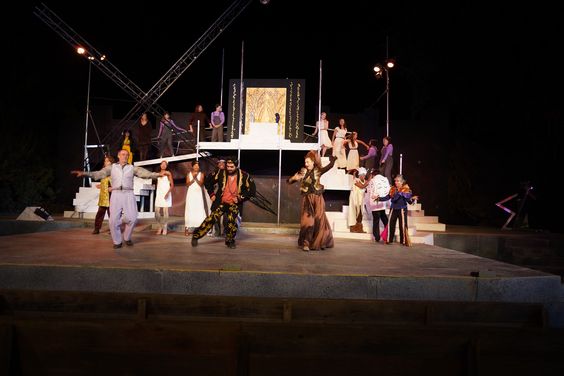
The cast on Jackson Currier’s set.
More Information
Pericles – July 14 – August 5, 2018, By William Shakespeare / Directed by Lesley Schisgall Currier
Forest Meadows Amphitheatre at Dominican University of California, 890 Belle Avenue, San Rafael, CA 94901
Performances at 8 pm Thursdays, Fridays, Saturdays and Sundays; and 4 pm Sundays. See website (www.marinshakespeare.org) for specific repertory performance schedule.
Phone: 415-499-4488
A Tale of Two Hamlets: A review of the Arabian Shakespeare Festival Production.
November 5, 2017 § Leave a Comment
At the center of the Arabian Shakespeare Festival’s current production of Hamlet are exceptionally insightful and original performances by William J. Brown III as the title character and Nathaniel Andalis as his bête noir and foil, Laertes. Without directly saying so, the production sidelines the more conventional antagonist, Claudius, with all-too-relevant implications.
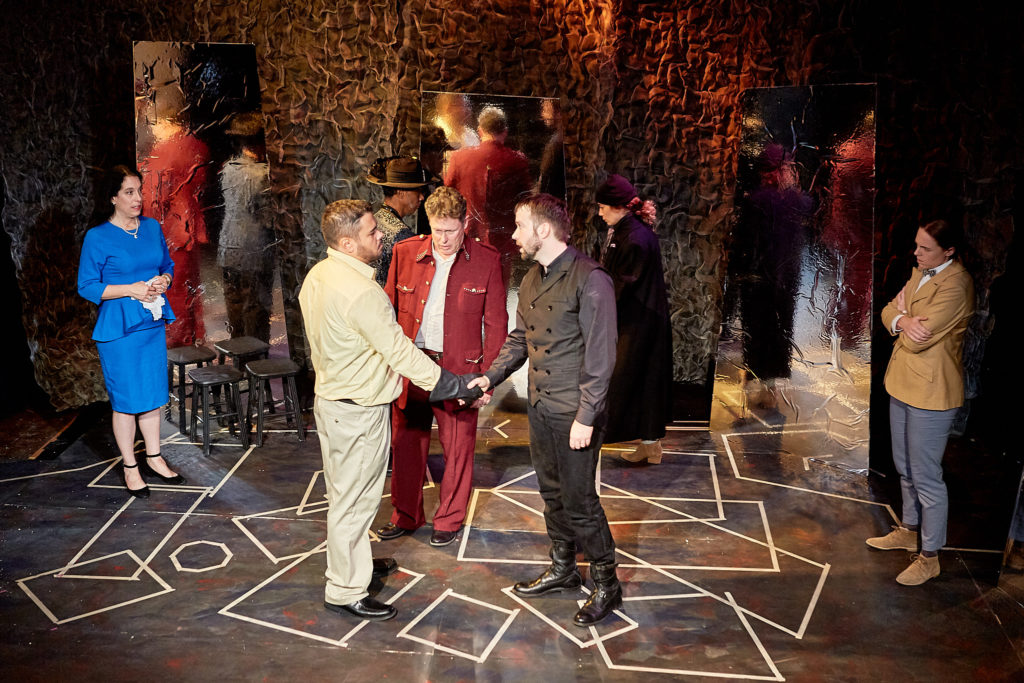
The cast of Hamlet, with Nathaniel Andalis as Laertes and William J. Brown III as Hamlet in the Foreground, John Flanagan as Claudius between them and Rachel Bakker as Gertrude, Norman Gee as Osric, Emily Keyishian as a courtier and Kate Rose Reynolds as Horatio looking on.
Hyperion to a Satyr
Of course, no play is thought to be so “universal” as Hamlet, so it is no surprise that any reading seems somehow current. Nonetheless, a focus on Hamlet’s disgust at the weakness of the current leader in comparison to his immediate predecessor, and his incredulity that anyone (let alone everyone) fails to see it, is so pregnant with contemporary implications that the production positively boils with renewed urgency.
John Flanagan plays Claudius as a weak and self-important ruler, so it is instantly believable when the play reveals he sleazed (rather than powered) his way into the job. Hamlet is too well-known for Claudius’ guilt to surprise anyone, but in this case, the production dwells on the patient investigation necessary to bring it into the open. Something IS rotten in Denmark, and everyone knows it, but out of pure self-interest no one will be the first to say so.
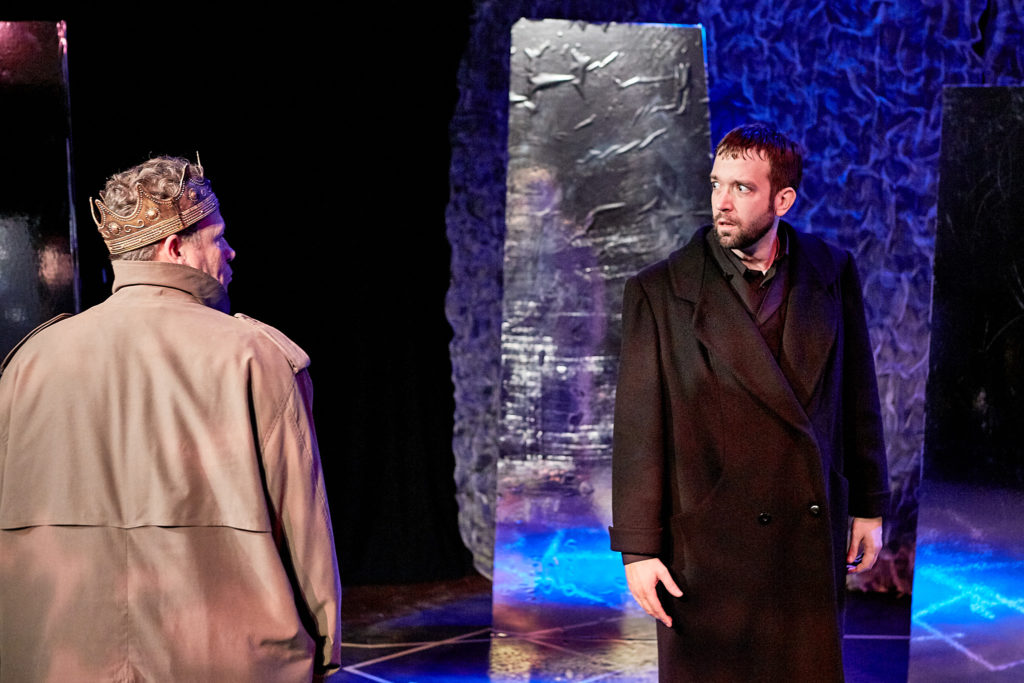
William J. Brown III as Hamlet, with John Flanagan as the Ghost. Photos by Gregg Le Blanc.
O Cursèd Spite!
Brown’s Hamlet is the opposite of the traditional conflicted and dithering naïf. This Hamlet is on the edge of rage from beginning to end. He has to fight for control of his passions, and struggles to apply the rationality he knows the situation demands if he wants justice and not just revenge. Brown is an exceptionally intelligent actor. His delivery of Hamlet’s famous soliloquies is slow and meticulous, but only because his Hamlet is so obviously forcing himself to reason through circumstances where he would rather rampage.
In this production the most powerful counter-force is Laertes who, like Hamlet, is another seeker of revenge for his father’s murder. Interestingly, the actor in this role is Nathaniel Andalis, who spent his summer playing the title role for the San Francisco Shakespeare Festival. Andalis is a charismatic performer with exceptionally deep connections to this play. (His bio says that he hopes to play all the roles in the play eventually, and in this production he is half-way to meeting this goal by notching up his seventeen role in the show.) Laertes exists in the show as a “foil,” a subsidiary character whose situation mirrors that the protagonist so that we might see both comparisons and contrasts. I’ve never seen this function so fully executed as it is in the performance Andalis delivers. I attribute this to the fact that he so deeply understands exactly how the role illuminates that of Hamlet, emotionally and thematically, because he brings such deep perception of the title role from his own experience of playing it. In a way, in this production you get to see two Hamlets – and they are both compelling. Placed in opposition to each other, they are explosive.
The company was rounded out by Rachel Bakker as Gertrude, Norman Gee as Polonius, Emily Keyishian as Ophelia, and Kate Rose Reynolds as Horatio. (All four also played several other parts.)
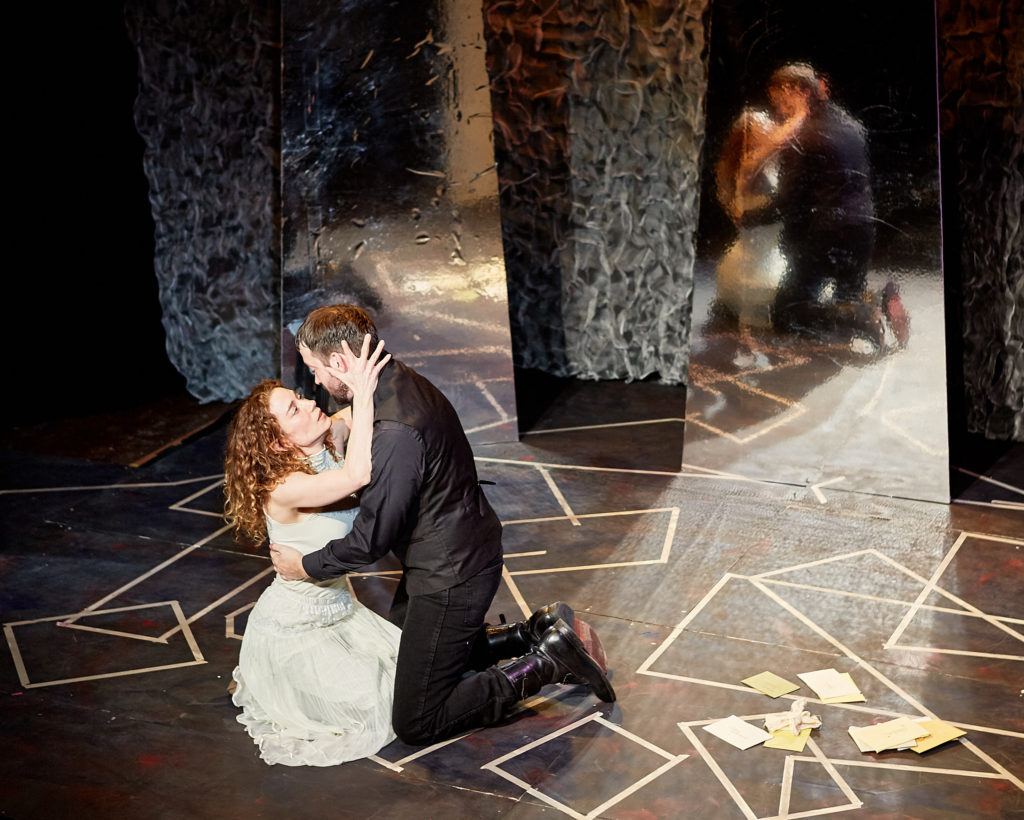
Brown as Hamlet with Emily Keyishian as Ophelia on Malcolm Rodgers reflective set.
A Great Reckoning in a Small Room
I am on record as a big fan of this small but interesting company. A couple of years ago they produced an Othello that thoroughly explored the title character as an Arabian Moor that opened completely new aspects of the play for me. Both pre-show publicity and program notes suggest that this Hamlet is also filtered through an Arabian viewpoint – although I do not think this displays overtly or that this information is necessary to appreciating their effort. The play, in fact, seems particularly relevant and compelling for reasons (outlined above) that seem far from the Arabian traditions of political revenge tales that it might be referencing. The obvious political implications as well as the preciseness of the investigation of revengers (in this case doubled because the Laertes is rendered as specifically as the Hamlet) is what makes this production unique.
The production is staged by Kevin Hammond, whose work tends to emphasize striking individual moments that don’t always cohere into a big picture. Some of those moments, however, (especially Hamlet’s encounter with Claudius at prayer) are stunningly effective and thought-provoking. Hammond’s greatest contribution was the dramaturgy of the production: The text was both abridged and intriguingly rearranged (into almost collage fashion).
Malcom Rodgers’ minimalist, mirror-laden set was evocative. Matt Stines’ sound design was subtle but brilliant. Patricia Tyler’s costumes, by contrast, were pedestrian and insistently realistic in a production that was otherwise built on theatrical convention. (The production is performed by seven actors jumping quickly in and out of multiple roles.)
The highlight of the night was the exceptional fencing match-turned-duel at the end of the play, choreographed by Andrew Joseph Perez. The fact that we were right on top of it in the tiny (40 seat) Royce Gallery contributed to the sense of danger, but such immediacy worked in the play’s favor here, and throughout the show.
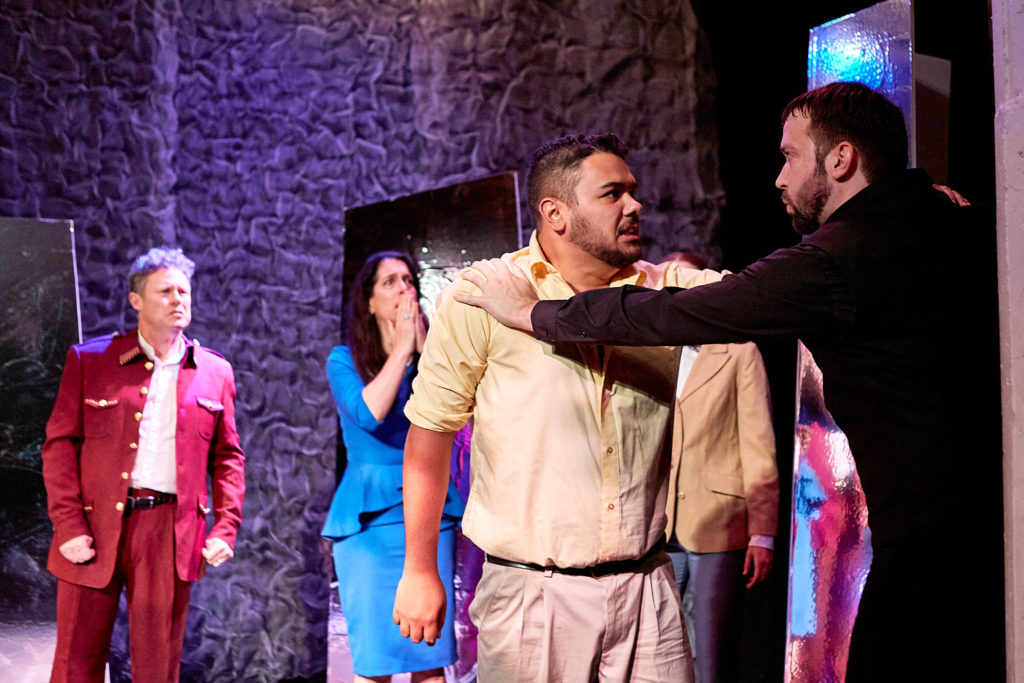
Nathaniel Andalis as Laertes and William J. Brown III as Hamlet (with cast members looking on)
Hamlet has a limited run, and there are few seats. If you love this play, this is an interpretation you don’t want to miss, with two stellar performances that you shouldn’t miss. See it while you can.
This article has been updated to credit director Kevin Hammond with the dramaturgy, and to include additional photos.
This review is of the Nov. 3 performance.
More Information
Hamlet plays through November 19th
(Thursdays- Saturdays at 8pm & Sundays at 2pm)
Royce Gallery (2901 Mariposa St., San Francisco, CA 94110).
Visit www.arabianshakes.org for tickets and more information.
What’s Your Problem?: A Review of MEASURE FOR MEASURE at CalShakes
September 27, 2017 § Leave a Comment
Measure for Measure, Shakespeare’s rhetorically brilliant but generically ambiguous “comedy,” is perpetually a problem. Tyne Rafaeli, directing for co-producers, the California Shakespeare Theater (CalShakes) and Santa Cruz Shakespeare, provides a fascinating approach that does not “solve” the difficult text (and in some ways complicates it even further) but does provide a set of visual tableaus and cleverly staged moments that make it especially relevant to the Bay Area audiences and the fraught political moment in which we live.
Why the play is so difficult is no particular mystery. Shakespeare adapted a completely tragic story (from the same source that he used for Othello) then – through the addition of a couple of hoary plot devices – restructured it into a comedy. Although everything does work out in the end, the tone of the play remains predominantly dark, however, so it is hard to know how lightly to take it and what to make of the moral dilemmas it poses.
Power and Perversion
The convoluted plot is the story of a Duke who is reluctant to exercise his power to maintain order, and so temporarily turns his duties over to a puritanical deputy with no such qualms. To set an example, the replacement ruler immediately sentences a young man to death for the relatively minor crime of impregnating his fiancé before marriage. The young man’s sister (a novice on the verge of taking her vows to become a nun) makes an impassioned argument for his life, which perversely just excites the cold deputy’s lust. He propositions her, offering the brother’s life in return. Faced with what is known in literature as the monstrous bargain she refuses. “More than our brother,” she declares, “is our chastity” – a position that modern audiences, at least, do not always find sympathetic.
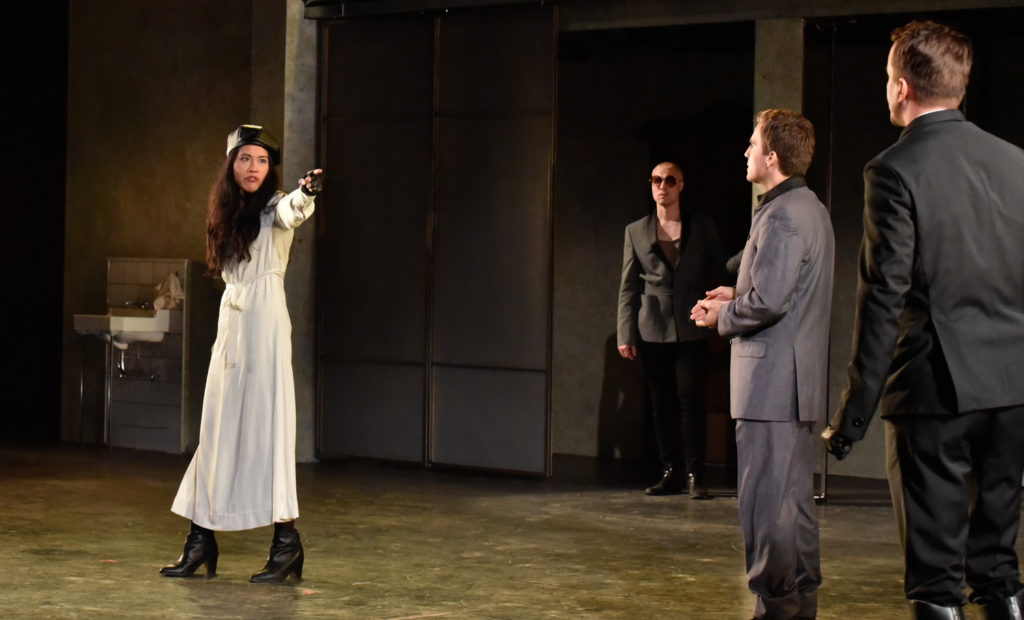
(L to R) Lindsay Rico (Isabella), Adam Schroeder (Lucio), Rowan Vickers (Duke) and David Graham Jones (Angelo) in California Shakespeare Theater’s MEASURE FOR MEASURE, directed by Tyne Rafaeli; photo by Jana Marcus.
Oddly, the Duke is lurking about in disguise and convinces the heroine to pretend to assent, and then substitutes the deputy’s rejected fiancé in the darkened bedroom. In a not-all-that-shocking twist the deputy, even though he is fooled by the substitution, still orders the execution to go ahead. The Duke has to struggle around in the background to prevent tragedy, and eventually resumes his position in order to set things right – just not until after he has convinced the young man that will have to die, convinced his sister that he did die, and convinced the hypocritical underling that he got away with it all. (Although manipulative, it is probably supposed to have a Big Yellow Taxi effect.) By the time the ending comes, when the Duke proposes to the would-be nun, the audience has been bounced between the poles of starkest tragedy and melodramatic relief several times.
Visualizing Psychology
Rafaeli imbues her production with an artificial urgency throughout, which makes it all look and feel much more like a farce. This certainly reduces the tonal whiplash we usually experience in productions of this title – but also rushes the detailed explanations of what is happening (and why) to the point that it is often far from clear to anyone not already familiar with the play what is transpiring.
What is genuinely original, and pretty wonderful, about the production is how Rafaeli makes many of the most difficult assumptions in the play more comprehensible through striking visual compositions. She stages the propositioning scene as a graphic sexual assault, sending the heroine initially into frozen shock – a haunting tableau that sums up the abuse of power and the helplessness of victims in a single image. Isabella’s subsequent revulsion at the idea of having sex, even to save her brother’s life, becomes psychologically comprehensible. (Given that we are living under a happily “pussy-grabbing” president, it also makes it inevitably political.)
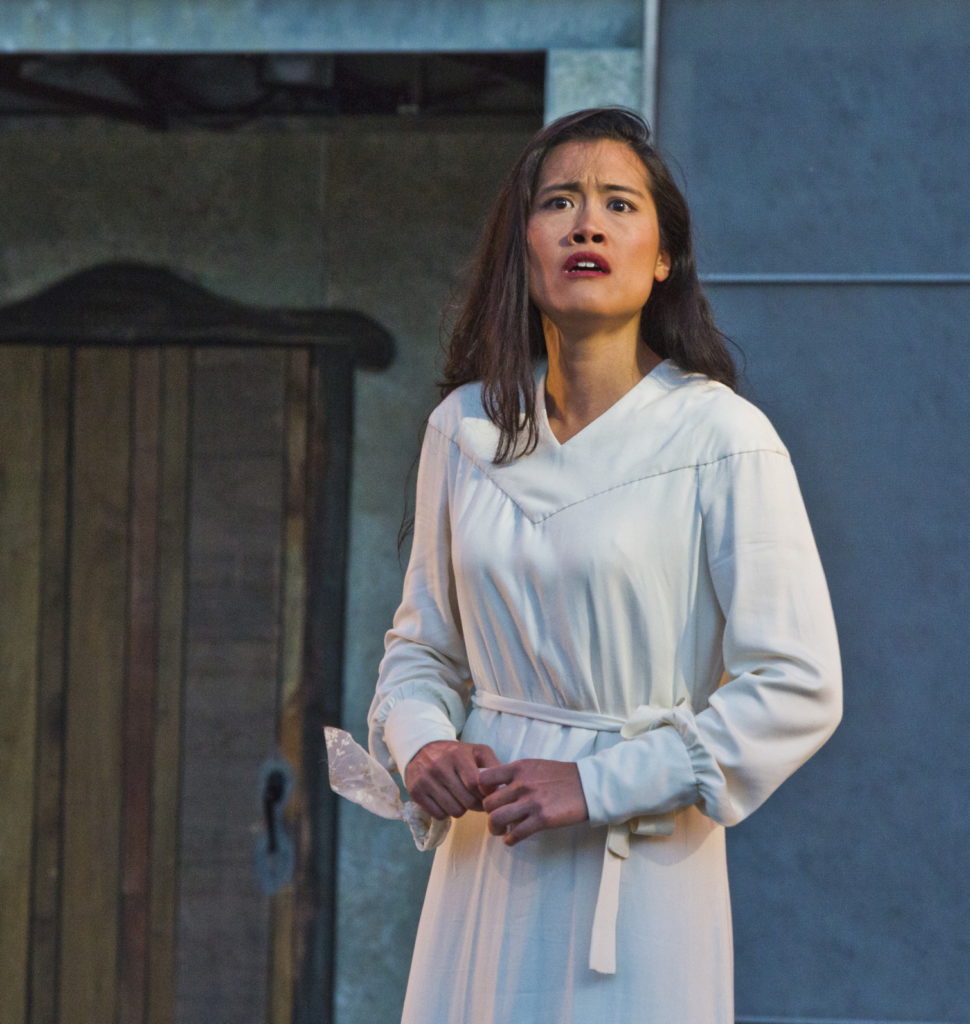
Lindsay Rico (Isabella) in California Shakespeare Theater’s MEASURE FOR MEASURE, directed by Tyne Rafaeli; photo by rr jones.
Her brother, whose punishment vastly outweighs his crime, is played by an actor of color. Rafaeli’s staging of his scenes of imprisonment with starkly contemporary details to the cell is surely meant to remind us of the injustices of our current system that disproportionately imprisons black and Latino men. A stumbling block for many Measure for Measure audiences is often that they find the overly-harsh sentence silly instead of serious, but in Rafaeli’s context it is all too plausible – again speaking to both the local audience and current moment.
A Different Kind of Setting for CalShakes
Throughout the play, Rafaeli uses the broad, shallow setting to create quick visual snapshots of important moments that remind us of nothing so much as eye-popping comic book panels freezing the action into bold compositions. Although wide and flat, Annie Smart’s set is both functional and effective for this purpose. It is very unlike the usual stage sets in CalShakes’ outdoor location where seeing into the far distance is possible. Montana Levi Blanco’s modern dress costumes often border on the whimsical. It is Kent Dorsey’s lighting that ultimately makes Rafaeli’s visual summaries burn into our consciousness.

Adam Schroeder and Annie Worden in Montana Levi Blanco’s fantastical costumes.
There are No Small Parts
To achieve the contemporary resonance, both verse speaking and self-conscious rhetoric were sacrificed to more physical approaches. As a result, the small players were often the most interesting members of the cast, especially Annie Worden’s rapid-fire turns as the Mistress Overdone, the Dogberry-like constable Elbow, the belligerent drunk, Barnadine, who farcically refuses to be executed, and Mariana, the heartbreakingly rejected fiancé of the false deputy who finally reclaims him from his own hypocrisy. CalShakes favorites Tristan Cunningham and Patty Gallagher also produce compelling and varied performances across a number of roles, as does newcomer Kevin Matthew Reyes as the brother, Claudio, and his polar opposite, the amusing pimp Pompey.
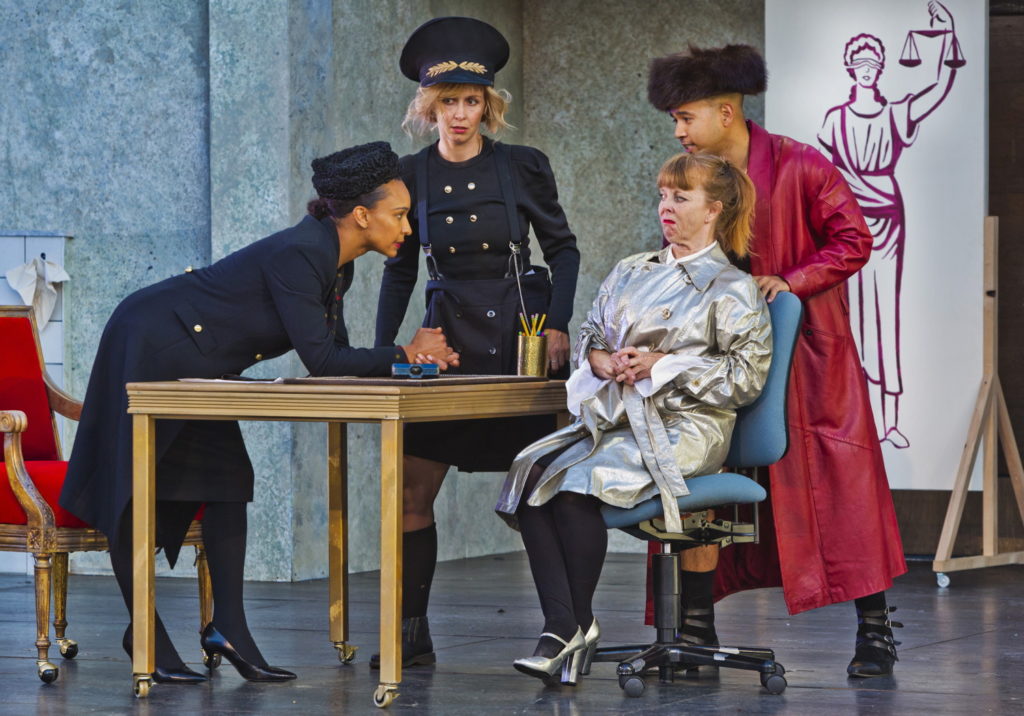
(L to R) Tristan Cunningham (Escalus) and Annie Worden (Elbow) question Patty Gallagher (Froth), and Kevin Matthew Reyes (Pompey) in California Shakespeare Theater’s MEASURE FOR MEASURE, directed by Tyne Rafaeli; photo by rr jones.
In the end, this production was a reminder that there is no such thing as a definitive staging of any Shakespeare play. There are endlessly fascinating possibilities, however. Measure for Measure is often a showcase for exceptional voices and fine verse speaking. It is almost unique to see it staged as a director’s vehicle emphasizing visual pictures and physical comedy. It is hard for me to remember any production of this show that was so closely tuned to place and time in which it was presented.
A Classic Reborn: a Review of BLACK ODYSSEY at CalShakes
August 14, 2017 § Leave a Comment
At the center of poet/playwright Marcus Gardley’s black odyssey (now playing at the California Shakespeare Theater) is the eternal impulse to retell a classic tale in order to claim it as one’s own. For those of us who regularly teach the classics, this is the lesson we seek to foster: the purpose of retelling these stories is not to perpetuate the past, but to connect to it. It is impossible to leave Eric Ting’s masterful production without feeling a part of something bigger than one’s own limited space and time.
A Paradox
Gardley’s reworking of the Homeric epic gains its force from the paradoxical rule that universality is achieved not by vacuous generality, but in precise specificity. On its surface, his play is about an African-American veteran of the contemporary (and ongoing) war in Afghanistan, named Ulysses Lincoln, who cannot find his way home. Over the course of the evening it becomes clear, however, that he is not so much geographically lost as spiritually at sea. His journey is not just finding his home, but finding himself.
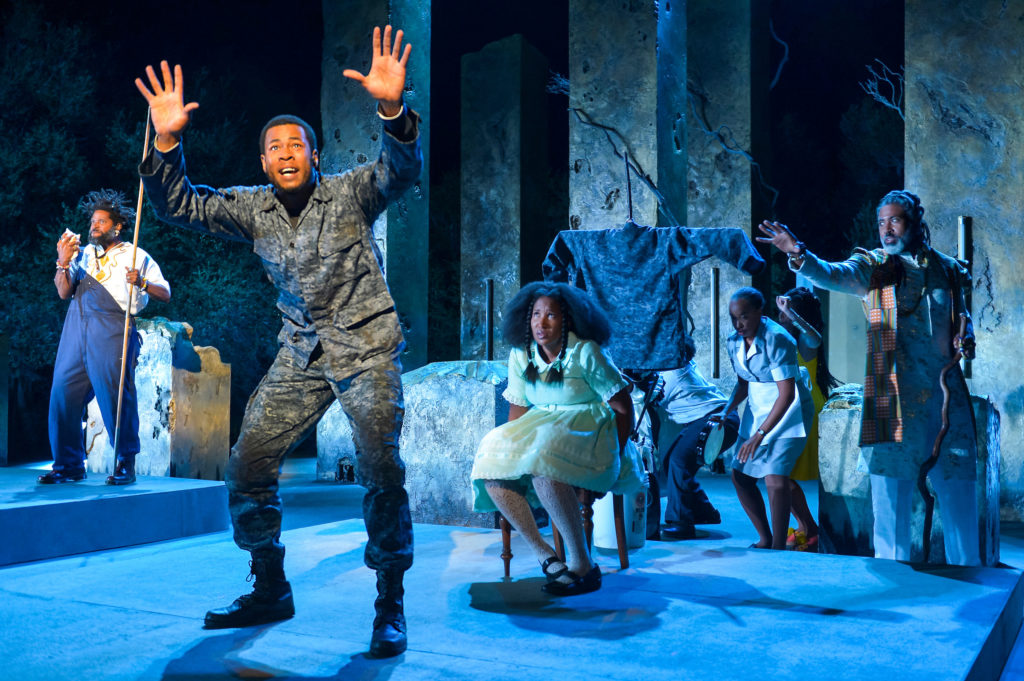
(l to r) Aldo Billingslea (Great Grand Paw Sidin), J. Alphonse Nicholson (Ulysses Lincoln), Safiya Fredericks (Benevolence Nausicca Sabine), Dawn S. Troupe (Alsendra Sabine) and Lamont Thompson (Great Grand Daddy Deus); photo by Kevin Berne
After being swept overboard of the ship carrying him home by a wave caused by the vengeful sea god, he washes up on a shore that – we slowly realize – is located both far from his intended destination and decades before he was born. The path to self-knowledge runs through the discovery of a history that was in some ways actively withheld from him through erasure and distortion, and in other ways that he actively fled when he joined the army to get himself out of Oakland. Although this is one man’s specific story, Gardley guides us to seeing beyond the surface, making it also a story about all of us.
Epic
Like any true epic, the plot is anything but linear. It is dotted with witty reïmaginings of the arbitrary and capricious Greek gods Paw Sidin (Poseidon), Aunt Tina (Athena) and Great Grand Daddy Deus (whose name is pointedly changed from Zeus to the Latin generic term for “god,” presumably because it also applies to the god of Christian tradition) who toy with human fate for reasons of their own. It retains the secondary story of the struggles of his wife, Penelope (here called Nella P.), and son, Telemachus (Malachai in Gardley’s version), to survive and retain hope, while placing them in a very recognizable 21st century Oakland. Often it focuses on the surreal experiences of the wandering Ulysses.
Along the way Gardley invokes Hurricane Katrina, the string of assassinations of civil rights leaders, Abraham Lincoln, JFK, Treyvon Martin, the death of Oscar Grant in the Fruitvale BART Station, reconstruction, and a host of other historical and local references that stir times and places together poetically. Painfully, I saw the opening night performance just hours after a white supremacist march in Charlottesville, Virginia, erupted in fatal violence against counter-protesters, which did not need to be directly referenced in order to be part of the mix.
A Great Feast of Language
Gardley is as much poet as playwright. His rhythms, rhymes and wordplay are both stunningly current and historically apt. For anyone who loves language black odyssey is a feast. CalShakes consistently demonstrates careful attention, not only to what is said, but how it is said. Gardley is at his most Homeric in his extravagant use of poetic artifice, and the producing company serves his inventive wit well.
The production heavily features music, especially arrangements of traditional spirituals. Vocal composers Linda Tillery and Molly Holm produced the strongest musical ensemble I have seen at CalShakes. (Tillery is also the credited Music Director, while Holm is also listed as Vocal Ensemble Director.) While I was less impressed with the brief forays into pop music in the second act, it is hard to underestimate how much of the overall impact of the production is built on the musical components. When the full cast is united in a choral moment, which happens rather often, the wall of sound they create is viscerally moving.
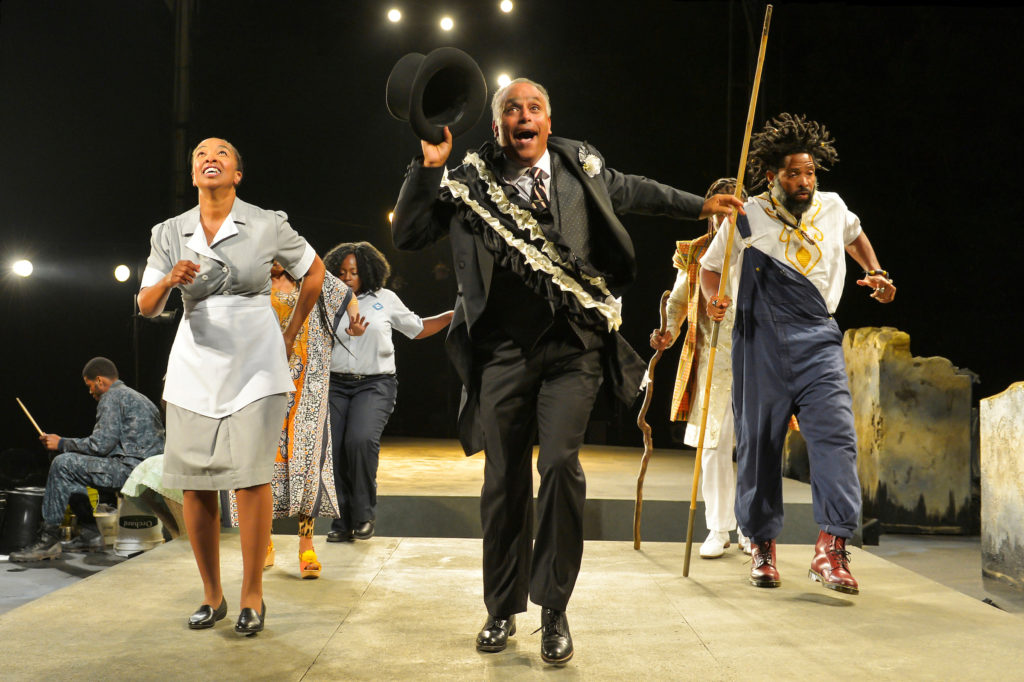
The cast of Marcus Gardley’s black odyssey directed by Eric Ting at California Shakespeare Theater; photo by Kevin Berne
Nine Stars
However much all of that matters, the evening is also about basking in the masterful performances of an exceptional cast. As Ulysses, actor/percussionist J. Alphonse Nicholson accomplishes the enormously challenging task of portraying a lost soul without fading from focus or losing his energy. His humanity and generosity as a performer letting us glimpse his innermost self allows us to identify with him intensely. Omozé Idehenre proves an emotional anchor for the entire evening as his long-suffering wife. Newcomer Michael Curry completes the family trinity as his son, Malachai, movingly and believably, even when the role shines an unsympathetic light on his character. In a conventional drama, this family grouping would be our entire focus and we would be content with such central performances.
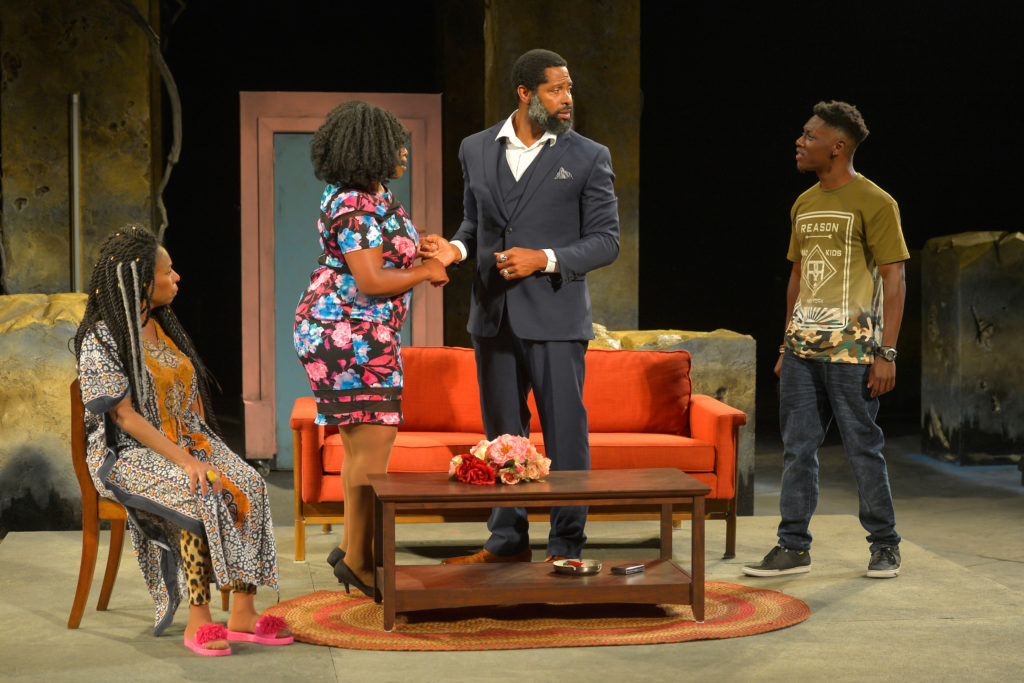
(l to r) Margo Hall (Great Aunt Tina), Omozé Idehenre (Nella Pell), Aldo Billingslea (Suitor), and Michael Curry (Malachai); photo by Kevin Berne
In this cast, however, the peripheral players are every bit as compelling. CalShakes regulars Aldo Billingslea and Margo Hall are powerhouses as the squabbling gods whose conflict lies behind Ulysses’ trials. Both also demonstrate astonishing versatility as they transform into their respective gods’ alter-egos. Billingslea invokes Paw Sidin as a coverall-clad levee fisherman but when he incarnates as a smooth-talking suit salesman wooing Nella P., a crisp military officer offering the wrong kind of solace when he brings news that Ulysses is lost and presumed dead, and a terrifying policeman, he appears completely different in each case. When Hall’s Athena sloughs off her immortality to become Aunt Tina, an aging and ill human, we see her change right before our eyes. And her invocation of Tina Turner (as one of the Sirens) is, well, let’s just say worth the price of admission all by itself.
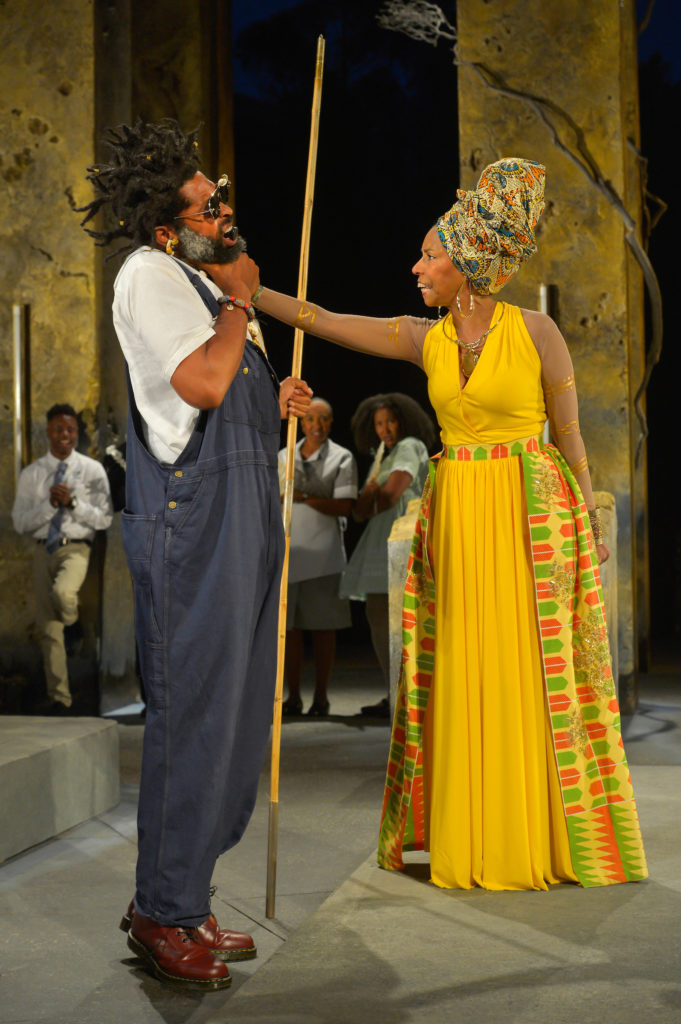
Foreground: Aldo Billingslea (Great Grand Paw Sidin), Margo Hall (Great Aunt Tina); rear: Michael Curry, Dawn L. Troupe, and Safiya Fredericks. Photo by Kevin Berne
Are these five great performers the magic number? Hardly. They are actually just the start of a cast of astonishing depth. Lamont Thompson as Daddy Deus is majestic, and in various minor roles he ranges from mysterious to hilarious. Bay Area playwright/performer Michael Gene Sullivan (best known for his work with the San Francisco Mime Troupe) appears – and sometimes disappears into – so many guises it’s hard to stay clear that it is the work of just one man and not a cast of dozens filling in. Dawn L. Troupe is Sullivan’s female equivalent in the cast playing a range of roles, sometimes prominent and sometimes almost invisible, providing enormous texture and depth to the play.
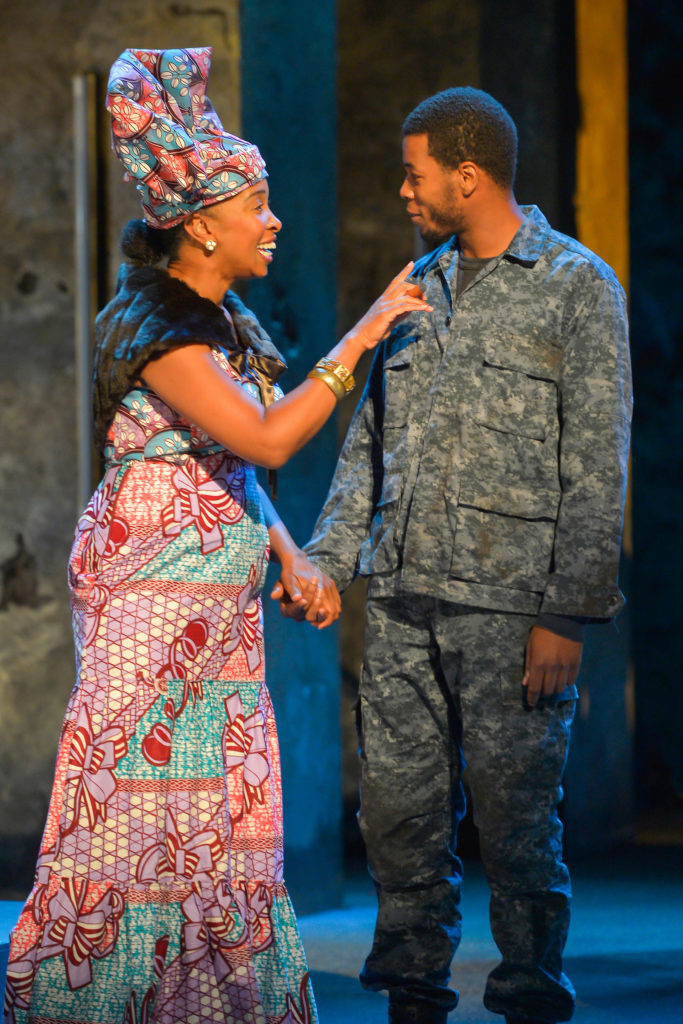
Dawn L. Troupe as Circe and J. Alphonse Nicholson as Ulysses Lincoln in Marcus Gardley’s black odyssey directed by Eric Ting at California Shakespeare Theater; photo by Kevin Berne
The nine-person cast is rounded out by Safiya Fredericks, whose light and amusing performance of Ulysses’ childish traveling companion conceals an artfulness and control that is only revealed when the entire play has unfolded. It is unfair that her masterful work cannot be discussed in detail without spoiling the play, but it can be said without harm that her genius lies in knowing when and how to unleash her talent, and it is worth the wait.
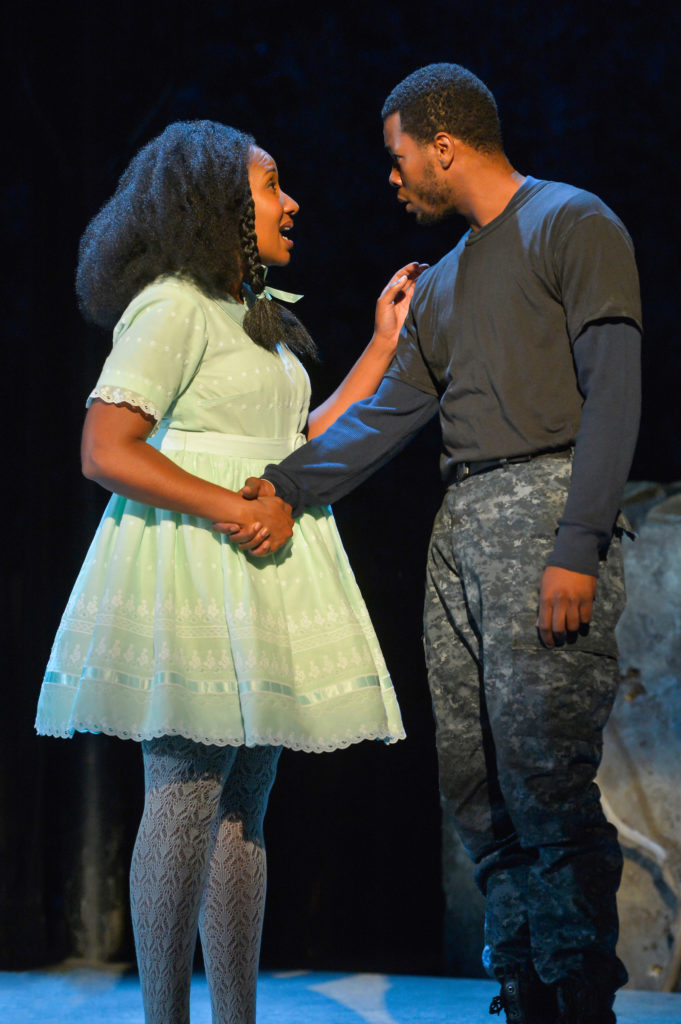
Safiya Fredericks (Benevolence Nausicca Sabine) and J. Alphonse Nicholson (Ulysses Lincoln); photo by Kevin Berne
One Small Man in a Huge World
The action of the play happens almost exclusively on an empty platform in front of Michael Locher’s monumental set, but the dynamic visual impression created by the towering (and crumbling) pillars sets the right tone throughout the night. Locher is especially successful at tying the stage space to CalShakes’ astounding natural setting in the Berkeley hills. That gorgeous view is always one of the pleasures of attending a CalShakes production. In a piece this grounded locally, it was especially admirable that the surrounding environment was featured. Abetted by the outstanding work of Lighting Designer Xavier Pierce, both the onstage action and the larger surroundings remain in balance. Thematically evocative, the image of one small man making his way in the huge world could not have been more beautifully rendered. Costumes by Dede M. Ayite successfully mix the mundane (for scenes of domestic depression) and the fantastic (in the otherworldly visions of Ulysses), which is not an easy trick to pull off.
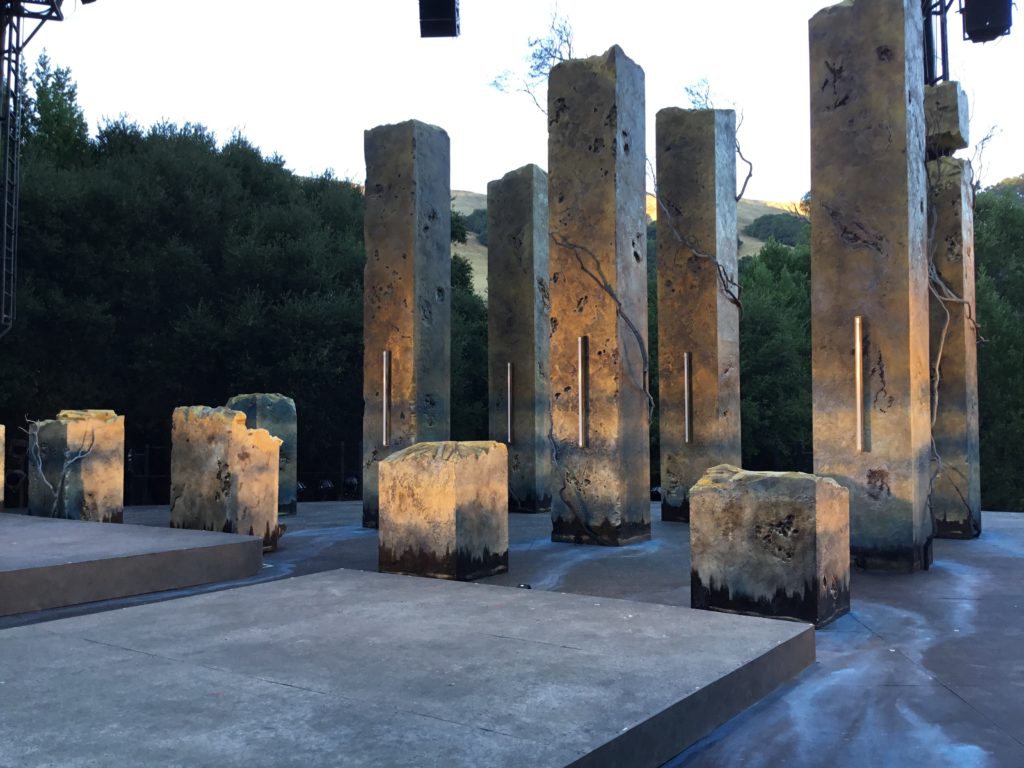
Michael Locher’s set lit by the pre-show sunset. Photo by the author.
Empathy
Ting’s directing is an astonishing act of empathy by a man who is, after all, of Asian-American decent, who is empowering an African-American cast to claim and interpret a story whose specifics are outside his direct experience. In his company debut as a director a year ago his Brechtian production of Othello proved controversial in part because (as is the way with such productions) we were not so much asked to empathize with Shakespeare’s hero, but told to do so. I am among those who actually like a stern lecture now and then and I liked Ting’s production, but I concede it was more Brecht than Shakespeare.
In this case, Ting seems an absolute servant to Gardley’s vision. It is hard for me to imagine that even those who found his Othello difficult will not find this an inviting experience. It is a sensitive and insightful rendition of a beautiful play, allowing a local playwright and cast to stake a claim on a work considered foundational to the Western tradition in a truly universal way. By making Homer their own they remind us that no one owns or directly inherits the past. We all have to find our humanity.
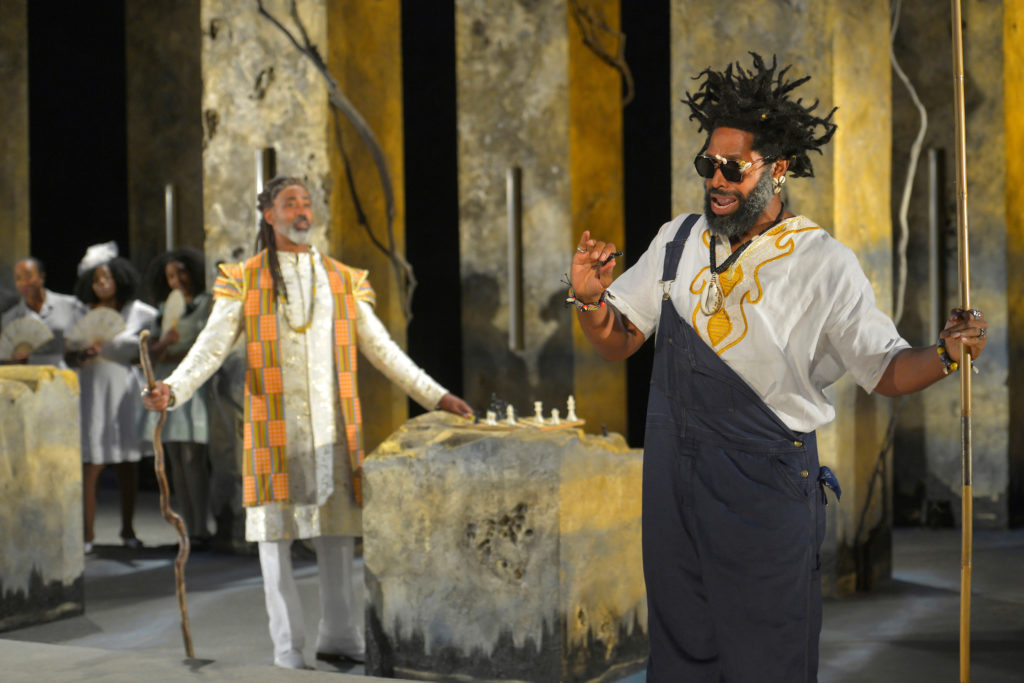
(l to r) Lamont Thompson as Great Grand Daddey Deus plays chess with Aldo Billingslea as Great Grand Paw Sidin, while Dawn L. Troupe, Omozé Idehenre, and Safiya Fredericks look on in Marcus Gardley’s black odyssey directed by Eric Ting at California Shakespeare Theater; photo by Kevin Berne
Production seen on August 12 2017
WHEN: through September 3, 2017
Tuesdays through Thursdays at 7:30pm, Fridays and Saturdays at 8pm, Sunday Matinees at 4pm
WHERE: Bruns Amphitheater, 100 California Shakespeare Theater Way, Orinda, CA 94563
INFO: www.calshakes.org
AS YOU LIKE IT, but like you’ve never seen it… at CalShakes
May 31, 2017 § Leave a Comment
Desdemona Chiang’s smart, contemporary production of As You Like It for CalShakes turns the play inside out, resulting in an extraordinarily moving and revelatory performance.
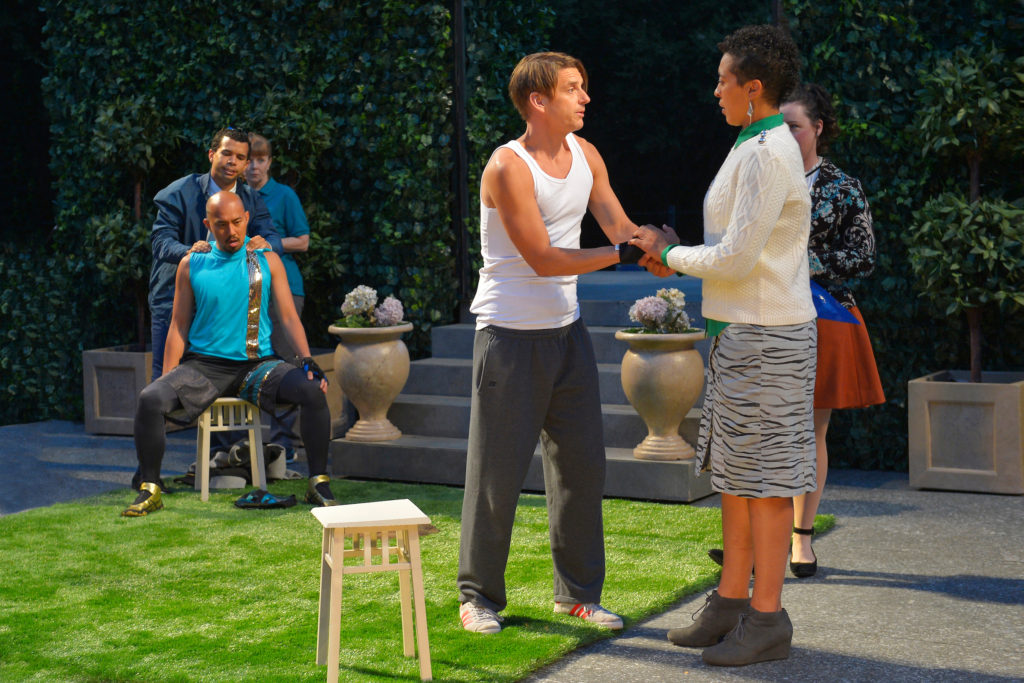
(L to R, front) Jomar Tagatac (seated) as Charles the Wrestler, Patrick Russell as Orlando and Jessika D. Williams as Rosalind photo by Kevin Berne.
Chiang takes everything we have come to expect from this pleasant (if usually light-weight) comedy and stands it on its head. From arrival in the auditorium until the curtain call, she finds unexpected depth and intensity by reimagining the setting, the period and the context of the show.
From Green World to Cityscape
The first glimpse of Nina Ball’s evocative set (waiting on the open stage of CalShakes’ beautiful outdoor location in the foothills just beyond Berkeley) is of a gorgeously manicured ivy-covered wall and topiary garden. Reversing the usual trope, this particular “green world” proves to be the unhappy home of the heroine, rather than the expected idyllic wood to which she will later be forced to flee.

Nina Ball’s beautiful “green wall” in the pre-show sunset.
When that heroine, Rosalind, is spitefully banished by her malicious uncle, she adopts male disguise and decides to seek her exiled father in the Forest of Arden. Ball’s set revolves and suddenly… we are in a dark, industrial back-alley, where the homeless and dispossessed occupy deserted loading docks stacked high with abandoned shipping containers. It is an apt contemporary analog for the dangerous backwoods of Shakespeare’s era, but unlike any design choice I have previously seen.
On the surface level, this resetting is not an easy fit. The rustics in the “woods” retain their pastoral concerns from deer hunting to sheep herding, while Rosalind (along with the cousin and court jester that agreed to accompany her) speak admiringly of the beauty of the place. The urban jungle we see and the idyllic pastoral vista we hear described are jarringly at odds.
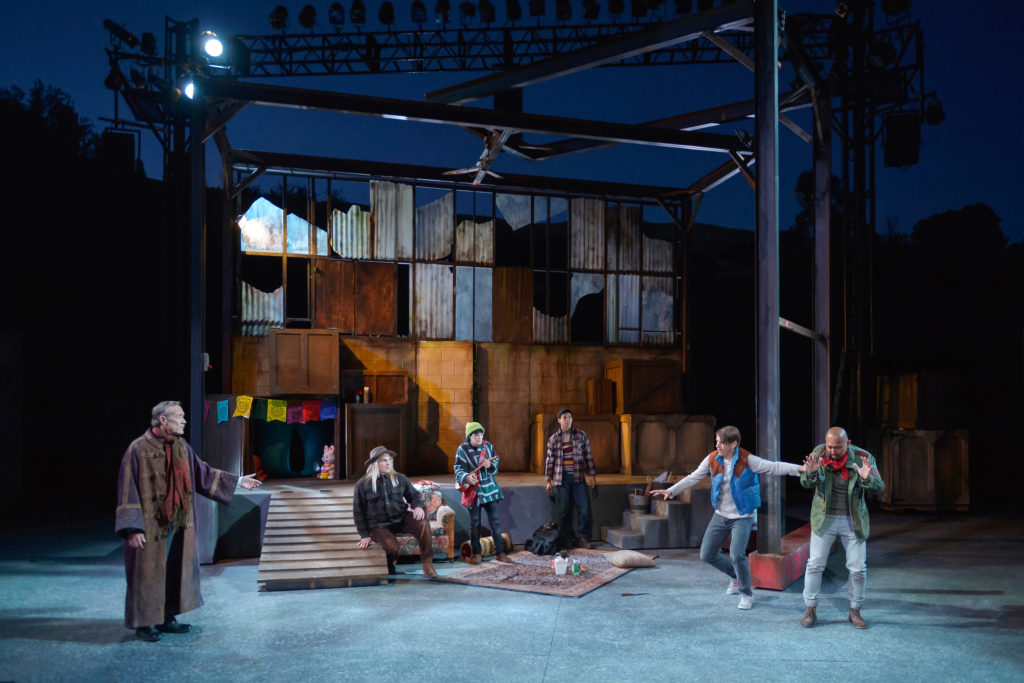
(L to R) James Carpenter (Duke Senior), Craig Marker (Amiens), Lisa Hori-Garcia (Second Lord), William Thomas Hodgson (First Lord), Patrick Russell (Orlando) and Jomar Tagatac (Jaques) on Nina Ball’s urban jungle set.
Chiang’s genius lies in slowly seducing us into an even-greater-than-usual suspension of disbelief so that we might look past these surface discordances and discover the play’s deepest core. Her allies in this are her exceptional design team, which in addition to Ball includes costume designer Melissa Torchia, lighting designer Masha Tsimring and sound designer Sharath Patel. They build a world that looks nothing like what is said to be their location, but feels exactly right for a place that is “uncivilized,” and therefore at once dangerous yet freeing.
Finding Ganymede
It is the performance of Jessika D. Williams as Rosalind that pushes the production to truly remarkable heights. In this dangerous new environment, her version of the protagonist has good reason to disguise herself as the male Ganymede, but in Williams’ interpretation what begins as a disguise becomes a discovery. Freed from social constraint, her Rosalind is not so much “performing” the part of a man as she is giving up “performing” the role of a woman. She finds a less-limited, stronger version of herself inside her disguise, and she likes it!
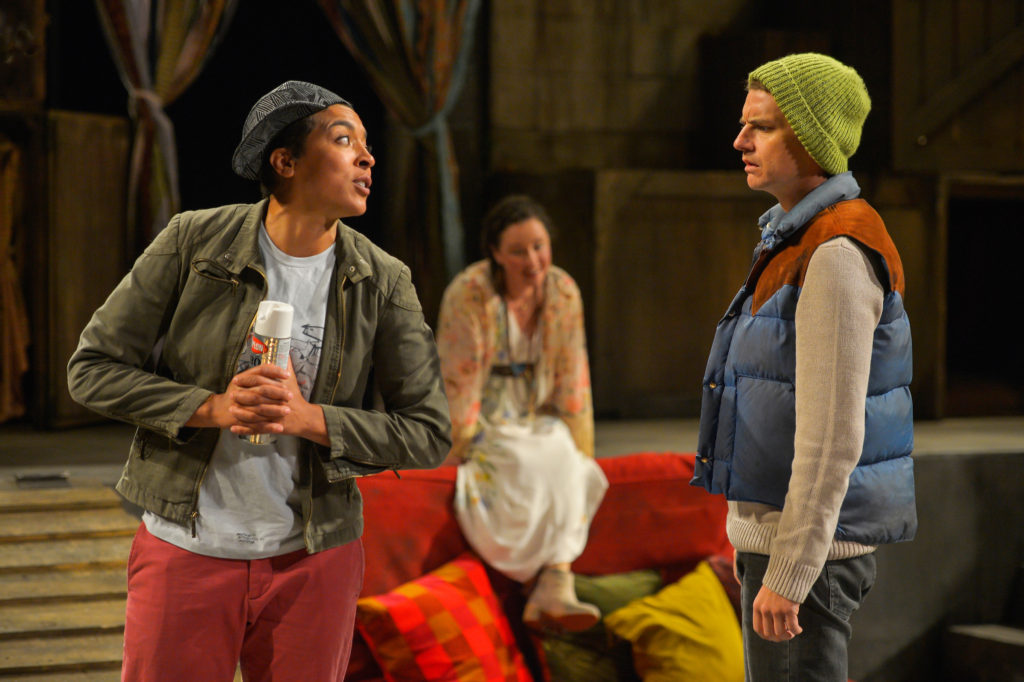
(L to R) Jessika D. Williams (Rosalind), Maryssa Wanlass (Celia), and Patrick Russell (Orlando), photo by Kevin Berne.
Patrick Russell plays her love interest, Orlando, more conventionally, but he has the courage to play his character as being as attracted to Rosalind’s male alter ego as he is to the “absent” Rosalind. Where he especially shines, however, is in a small scene usually played with a light touch where, penniless and hungry, he demands food at knife-point from a group of homeless people enjoying a communal meal. Rather than make fun of the character’s ineptitude at bluffing, Russell plays the scene with believable, fearful recklessness. Even while bringing sympathy to his character’s desperation, he nonetheless seems genuinely dangerous when holding Jacques hostage.
All the World’s a Stage
The high point of the evening follows quickly upon this moment. As a man who genuinely believed only moments earlier that he was going to die at Orlando’s hand, Jomar Tagatac delivers the famous “seven ages of man” speech with an immediacy and specificity that made it integral to the play and indescribably moving. As the melancholic Jacques, Tagatac is extraordinary all night long, which is little surprise to anyone who saw his unforgettable turn in Life Is a Dream at the same theatre two summers ago. His performance, alone, is worth the price of your ticket.
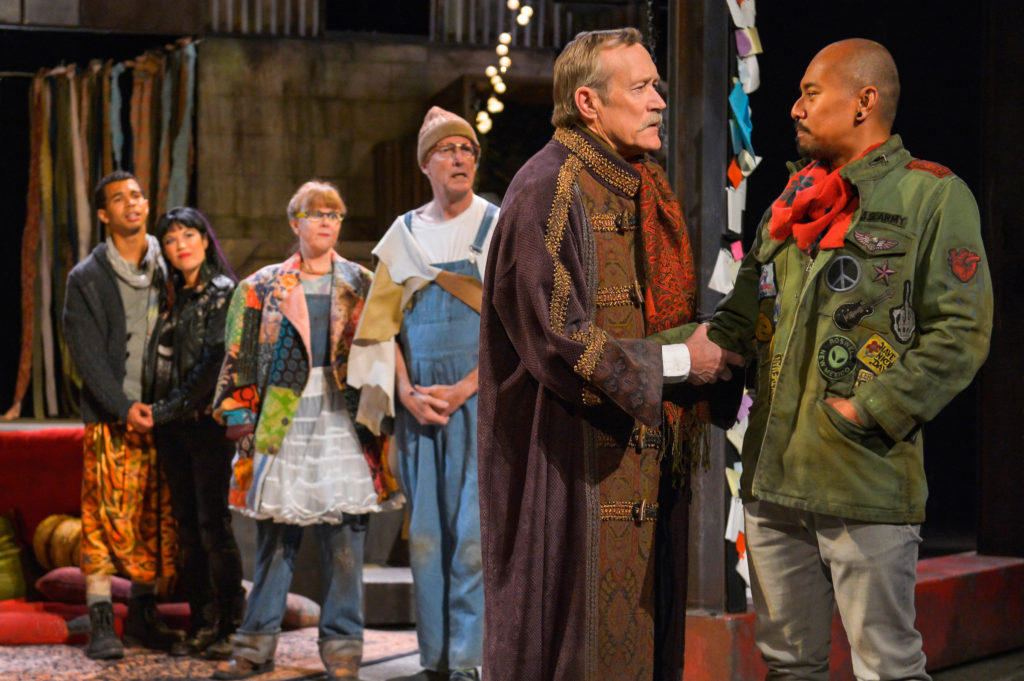
(L to R) William Thomas Hodgson (Silvius), Lisa Hori-Garcia (Phebe), Patty Gallagher (Audrey), Warren David Keith (Touchstone), James Carpenter (Duke Senior) and Jomar Tagatac (Jaques), photo by Kevin Berne.
Company stalwarts James Carpenter as both the usurping and deposed dukes, Patty Gallagher as the unsophisticated country- (or in this case, city-) bumpkin, Audrey, and Warren David Keith as the jester, Touchstone, are uniformly wonderful in their supporting parts. Maryssa Wanlass as Celia, Craig Marker as Oliver, William Hodgson as Silvius and Lisa Hori-Garcia as Pheobe complete the cast, in which there is no weak link.
Ending by Not Ending
The denouement of the play is always a little odd, as the text prominently features a deus ex machina for which we are even more than usually unprepared, but Chiang makes her most deliberate textual changes of the night to this ending by simply eliminating most of it. It is not just her Rosalind who has no desire to change back into a woman. The whole production is most comfortable in the transformative “green world,” and in the end it stays there. After the curtain call, Rosalind’s super hetero-normative epilogue is retained, but so peppered with gender-queer and LGBTQ-friendly asides from the rest of the cast that it ends by meaning exactly the opposite of what it says on paper… thank heaven.
CalShakes is the largest and most sophisticated of the Bay Area’s summer Shakespeare festivals. Its new artistic director, Eric Ting, seems determined to maintain and extend the company’s progressive reputation. In his own directing debut for the company last season, he produced a notable – and notably controversial – Othello, which was pointedly political, via a hyper-Brechtian performance style. As You Like It goes about making its social commentary in a more indirect way, but is every bit as revolutionary. What a great start to the Shakespeare season!
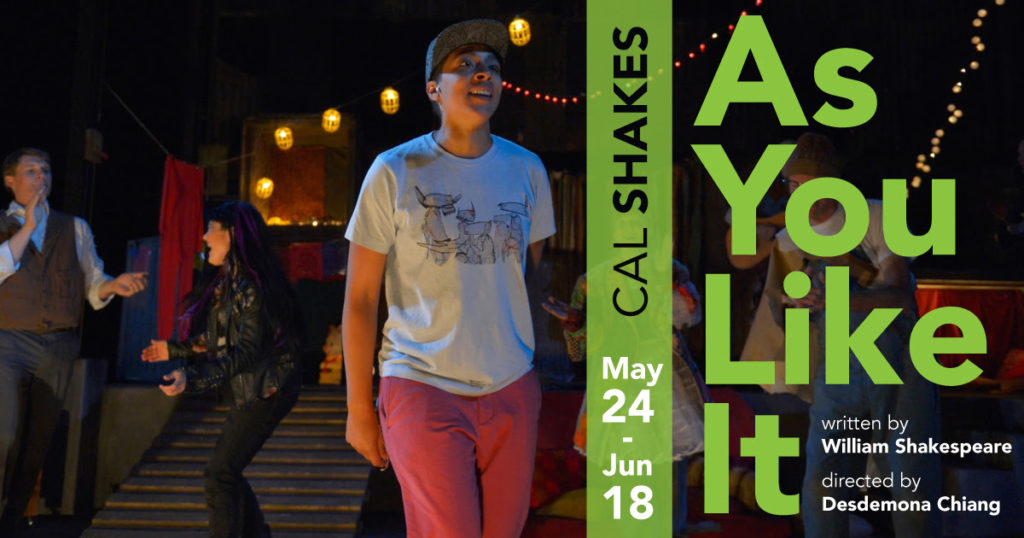
Production Information
AYLI, viewed on May 27, 2017
California Shakespeare Theatre
www.calshakes.org
(510) 548-9666
Tickets $20-96
Bruns Ampitheater, 100 California Shakespeare Theatre Way, Orinda, CA 94563
Tuesdays-Sundays through June 18
Minimalist Tragedy: MACBETH at the Arabian Shakespeare Festival
October 2, 2016 § Leave a Comment
Teddy Spencer is a San Francisco-based actor with a Benedict Cumberbatch-ish look and appeal. He is tall and lanky, possessed of a warm baritone and radiating intelligence. He can be hilariously self-effacing, even goofy, when performing comedy but he is also a formidable tragedian. I first saw him as Orlando in As You Like It at the Marin Shakespeare Company, but it was after seeing him as a steely Iago in Othello with the Arabian Shakespeare Festival that I became a genuine fan. Now he has returned to the latter company as Macbeth in a production that places the focus squarely on him, and he is hypnotic.

Teddy Spencer and Radhika Rao as the Macbeths. Photo by Gregg Le Blanc.
The Arabian Shakespeare Festival is an emerging company under the artistic direction of William J. Brown III. Their mission is to use theatre as a cultural bridge between the Middle East and the West. (Their current production is heavily supported by a sizeable gift from The People of Kuwait.) I was enormously impressed by the previously-mentioned production of Othello, which explored the tensions of assimilating Arabs by taking seriously the Elizabethan connotation of “Moor” to imply someone of middle eastern origin. It was timely and thought provoking.
Their Macbeth is less conceptually related to their mission, as it does not directly imply an Arabian connection despite a passing reference to the Arab Spring in the director’s notes, but that is possibly because any play about an obsessively ambitious strong man coming to power inevitably has more immediate connotations during this frightening election season. The evening’s virtues are quite different from those of the last time I saw this company.
The Real Curse
There is a rich folklore about the cursed nature of the play, but real theatrical insiders will tell you that the main way that it is blighted is that it reads much better than it stages. Despite the high esteem in which the playtext is held, surprisingly few productions of the play come off well. To modern audiences the supernatural element is often silly instead of frightening. Bucket loads of stage blood can, and usually do, become unintentionally hilarious. Relentless misogynistic interpretations of Lady Macbeth often sink the enterprise before it really launches. The reader can find it spooky without “jumping the shark” in their own mind’s eye, but it is downright difficult to make the play work when it has to be materially realized. In performance, it is best to leave a lot to the imagination.
There are some deep textual complexities that cause a lot of issues with producing the show. The only text of the play we have is from the 1623 First Folio of Shakespeare’s work, but scholars have clearly established that that version contains material inserted from a much later play, The Witch by Thomas Middleton, and that Middleton is probably also responsible for heavily cutting and arranging the original text into a streamlined performance text. (Shakespeare could not have inserted the material himself, because Middleton’s play was not written before he died, and therefore probably did not cut it himself either.) The version we have is full of plot holes and contradictions, with an uneven pace. The action flies by in the first half and then grinds to a slog in the second. Lady Macbeth is a powerful presence in the beginning but fades into the background once she becomes queen. Character development in the minor roles is truncated, and sometimes just confusing. It takes some very intensive dramaturgy to keep the play on track.
Keep It Simple, Stupid
Director Terri McMahon avoids many of the most deadly traps by keeping things very simple. A cast of six, performing on a virtually empty set, with minimal props, no fake blood, and evocative contemporary costume bits and pieces performs the show in a drastically cut, fast moving, version of the play. The staging is clean and efficient, with a few moments of clever theatricality. The direction is enhanced by two striking ideas: Nathaniel Andalis, who plays Banquo, continues in a highly original extension of that role to appear onstage after his murder not only as the ghost at the banquet, but also as the visions conjured by the witches, then as the embodied curses and ultimately as a physically manifest malevolent supernatural force intervening against Macbeth. It was both unfussy and theatrically effective. McMahon also chose to place Lady Macbeth’s death (which in only reported in the text) fully onstage and left her body downstage center while the final duel played out. Radhika Rao avoids the clichés in her portrayal of Lady M, and is moving in her later scenes, especially in this interpolated death scene, but the production’s focus is elsewhere.

Nathaniel Andalis as Banquo, Nicole Weber as Fleance, and William J. Brown as Duncan
Actors William J. Brown III, Kirsten Peacock and Nicole Weber do some heavy lifting by rapidly shifting between multiple characters – playing something like half a dozen each. (In a fine show of virtuosity Peacock plays both Macduff and Lady Macduff in the production, both compellingly.) The performance space at the Royce Gallery is tiny, and in combination with the small cast and shortened play, there is little spectacle. Battle scenes and other parts of the play usually populated by crowds are stripped away almost to nothing. Most of what powers a typical production forward is absent from this one altogether.
All that is sacrificed produces one overwhelming and original insight into the play, and makes it riveting. In this minimal staging, we realize that a great deal of the play is surprisingly intimate, and blossoms in this unforced simplicity. Lady Macduff has a touchingly domestic scene with her doomed son. Banquo teases and teaches his son, Fleance, in an almost casual fatherly moment of calm amidst the crisis. The Macbeths agonize over whether to move forward huddled together in a tiny hallway. In stark contrast to the histrionics usually employed, this production favors small, introverted moments.
In this tightly-focused, sometimes suffocating, atmosphere Spencer performs a beautiful miracle. He pulls us into Macbeth’s soliloquies with such unwavering intensity that we actually root for this man. His performance is so contained it feels almost private, but his voice and face are so expressive it is like constantly watching him in cinematic close-up. He seductively whispers his innermost fears, dreams and delusions to us until we feel we have direct access to his damaged (and ultimately damned) soul.
This is not a performance built on charisma and starpower, although Spencer has plenty of both. It is just an actor with enormous courage letting us into his unguarded and unfiltered core. Of the many productions I have seen, this is the first time I have felt that I truly understood the human tragedy of a man who lost himself. In a very Hamlet-ish performance, Spencer fully realizes the protagonist reaching for his destiny, dancing with madness, and ultimately facing death squarely.
It is a small company with a brief run, that deserves your support and attention. Treat yourself and go see this performance.
Production information, per the Festival’s publicity poster:

Seen Sept. 30, 2106.
